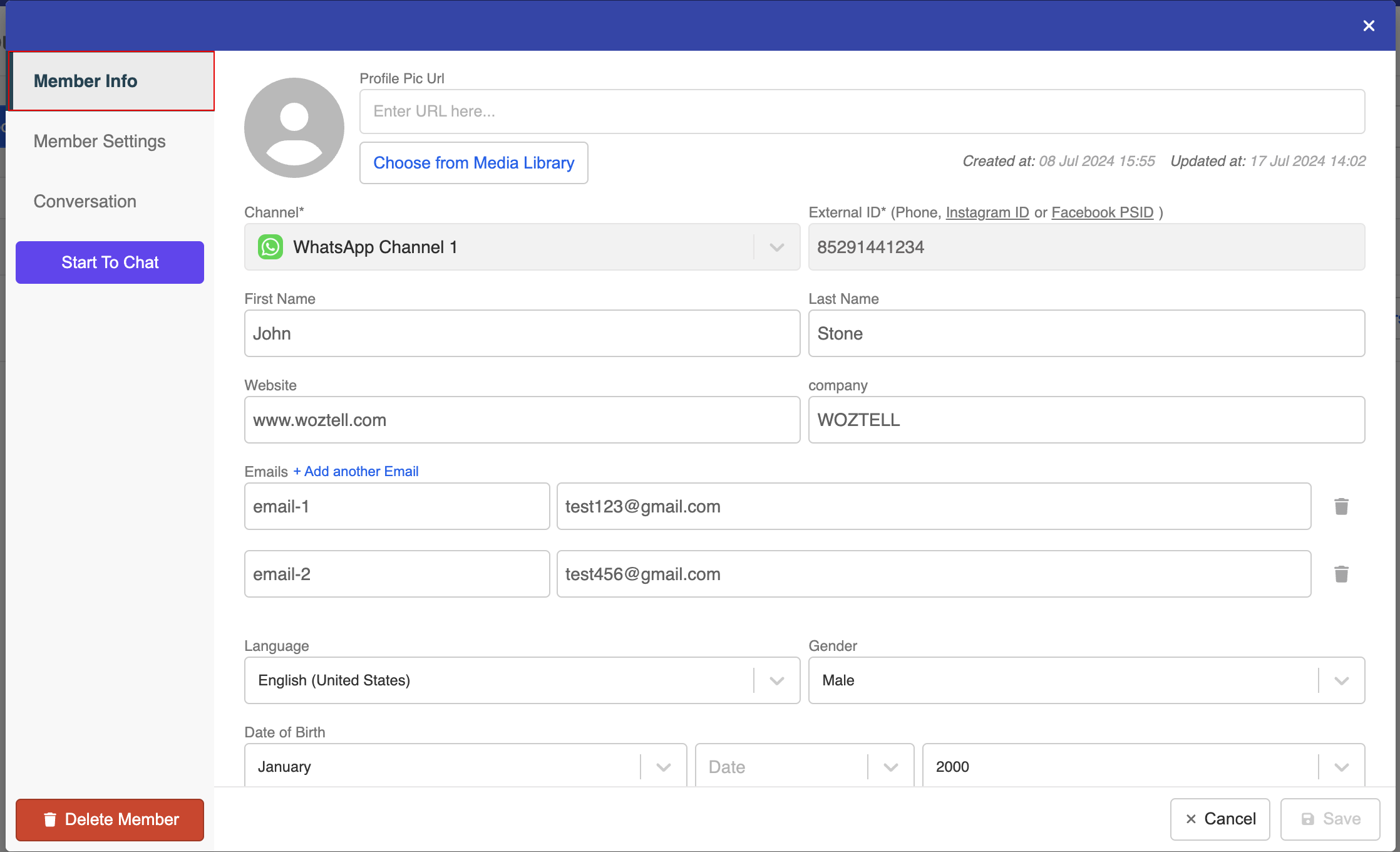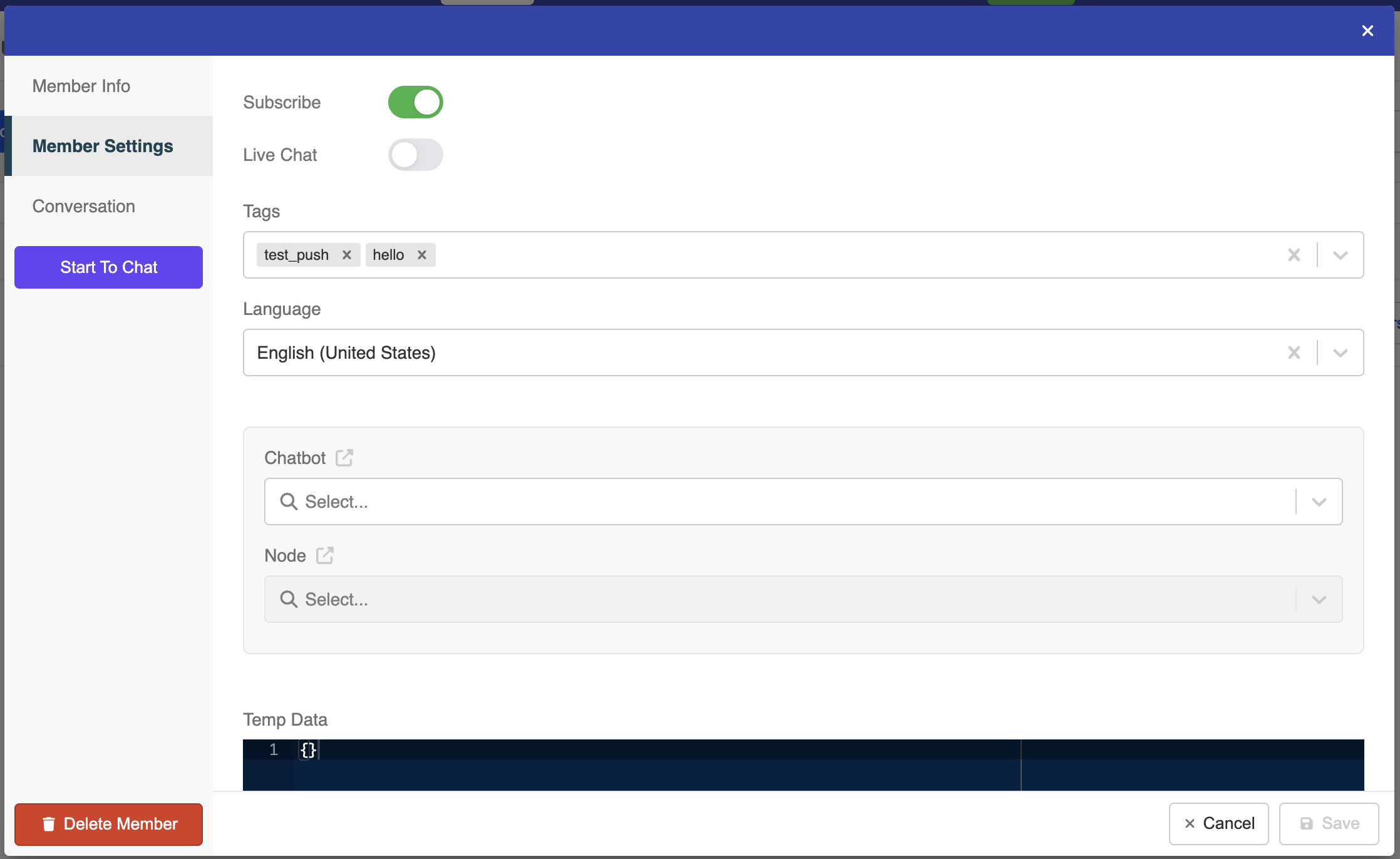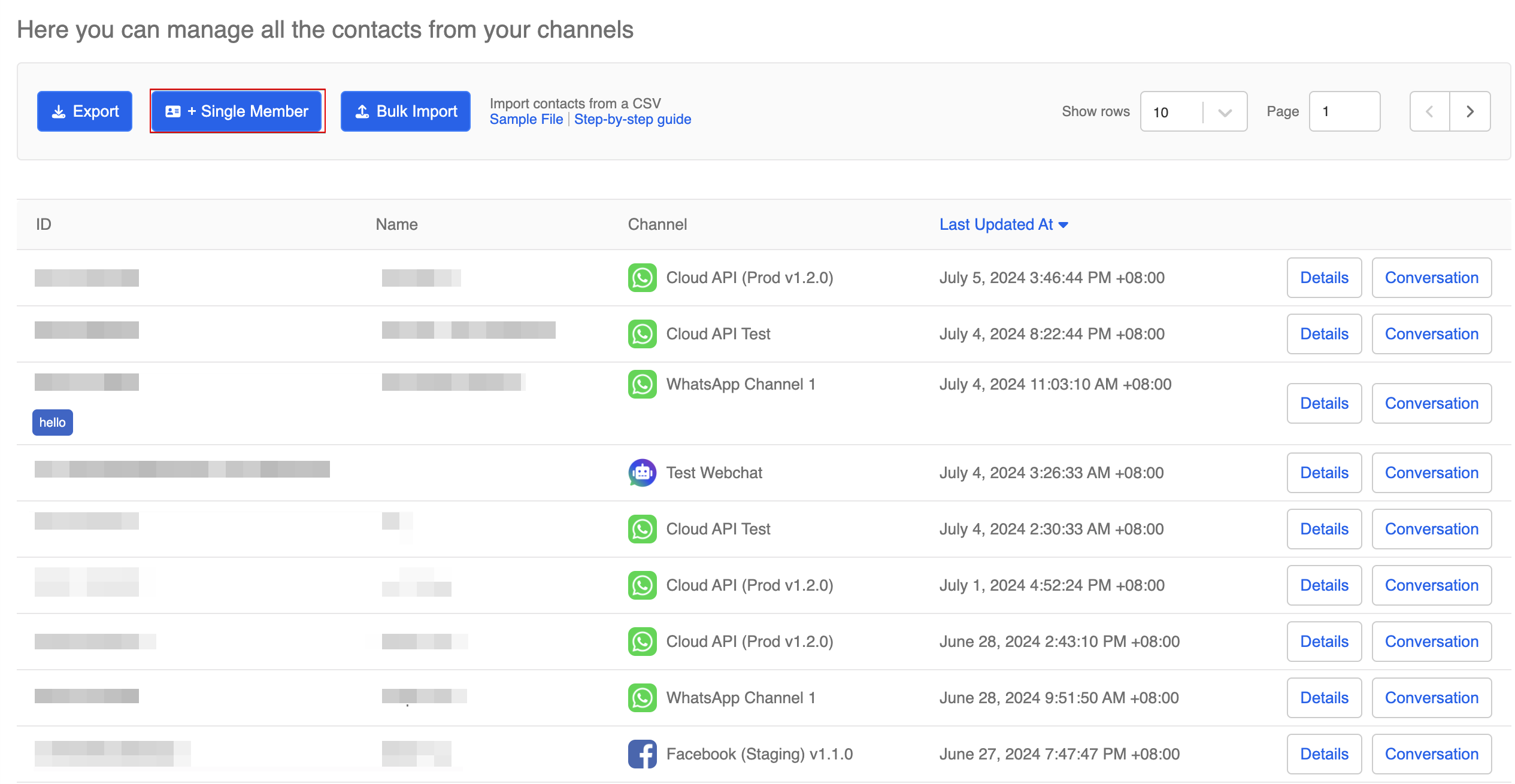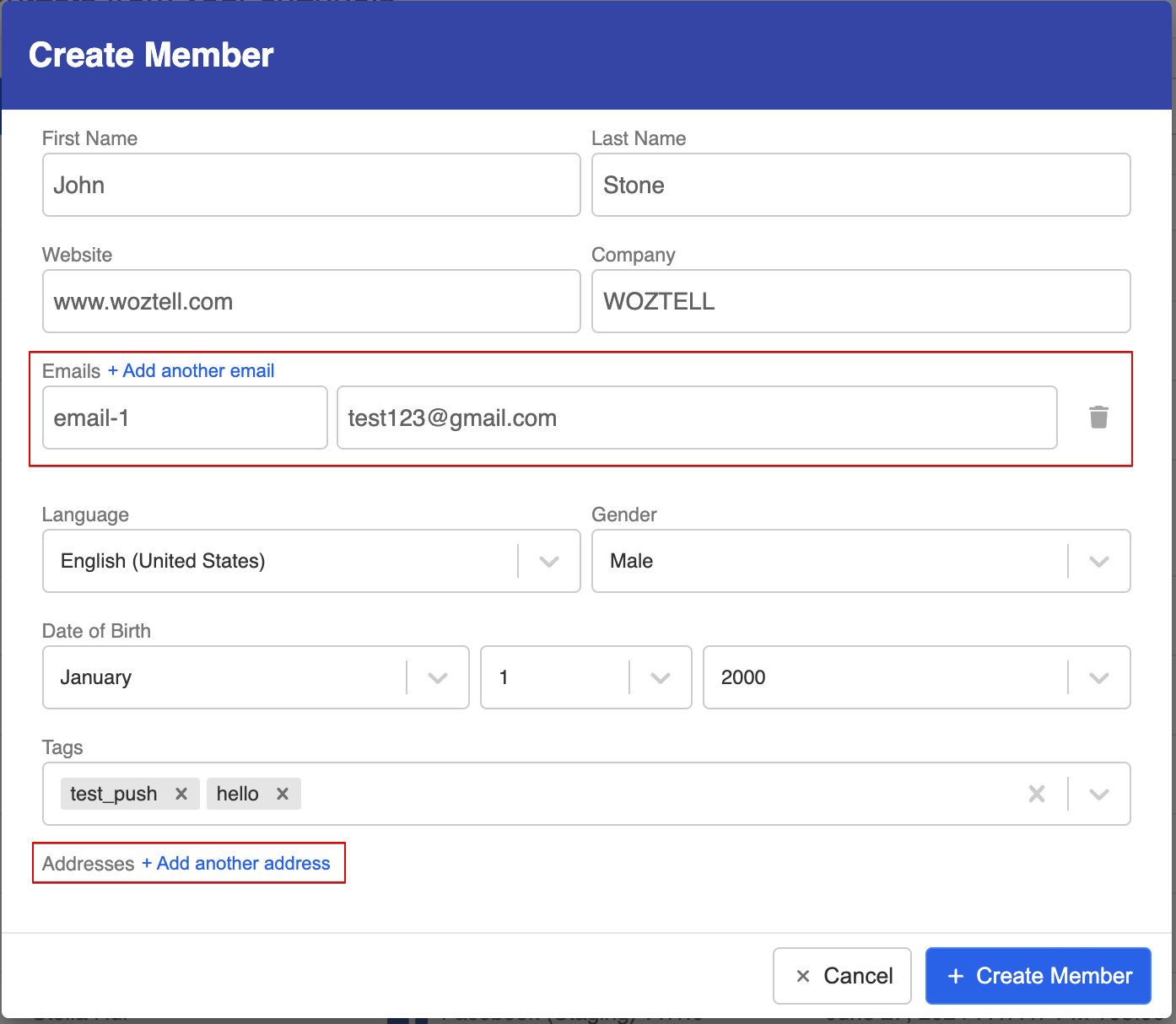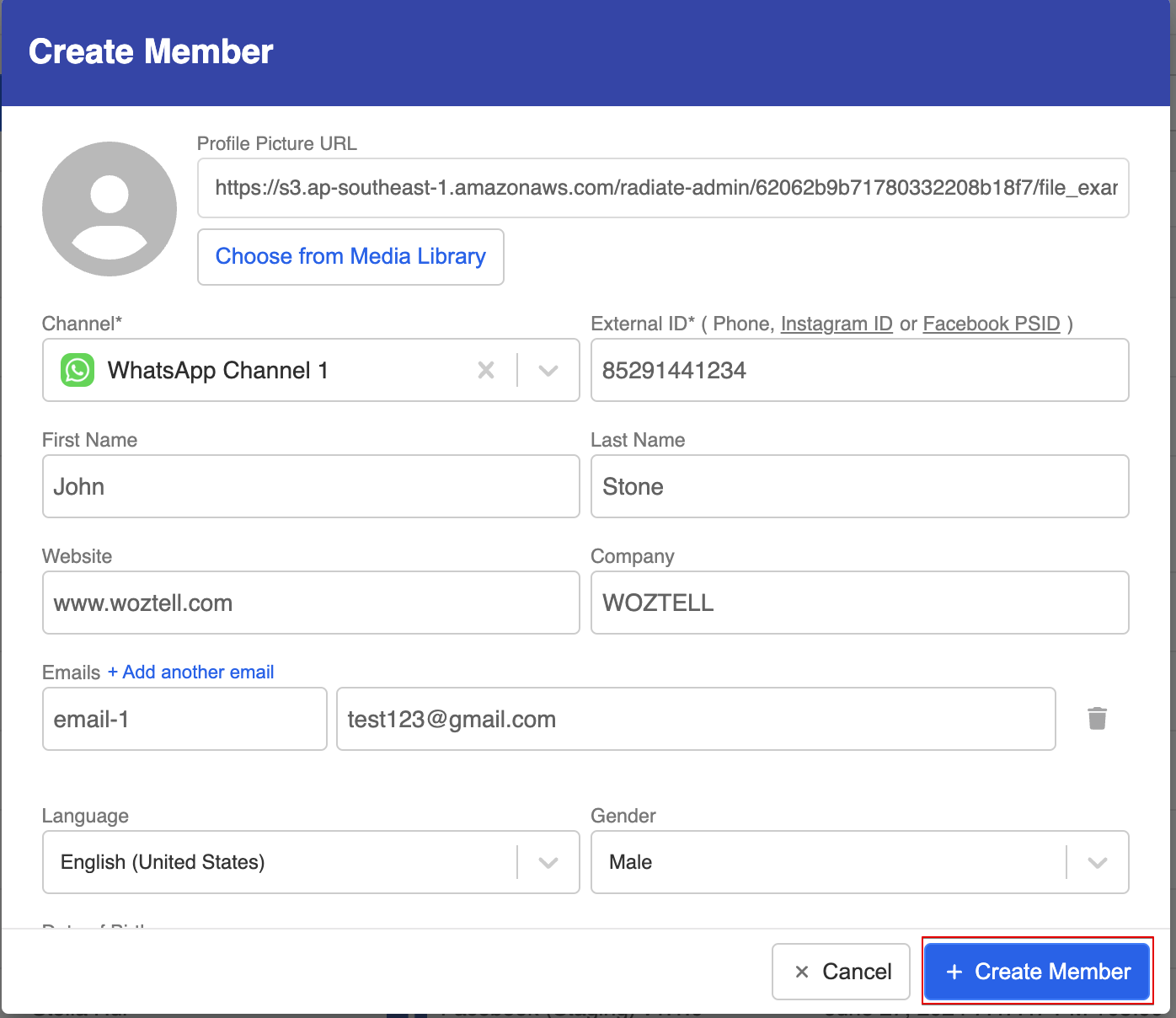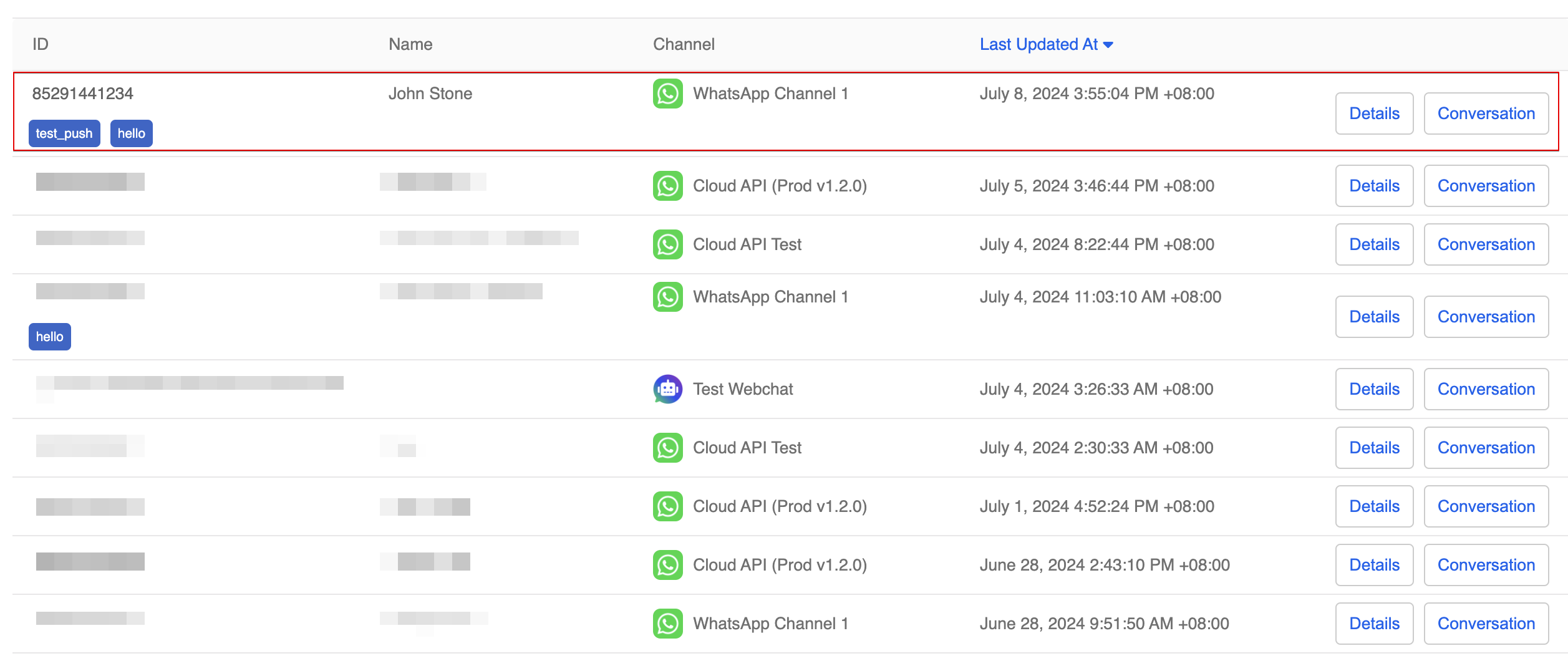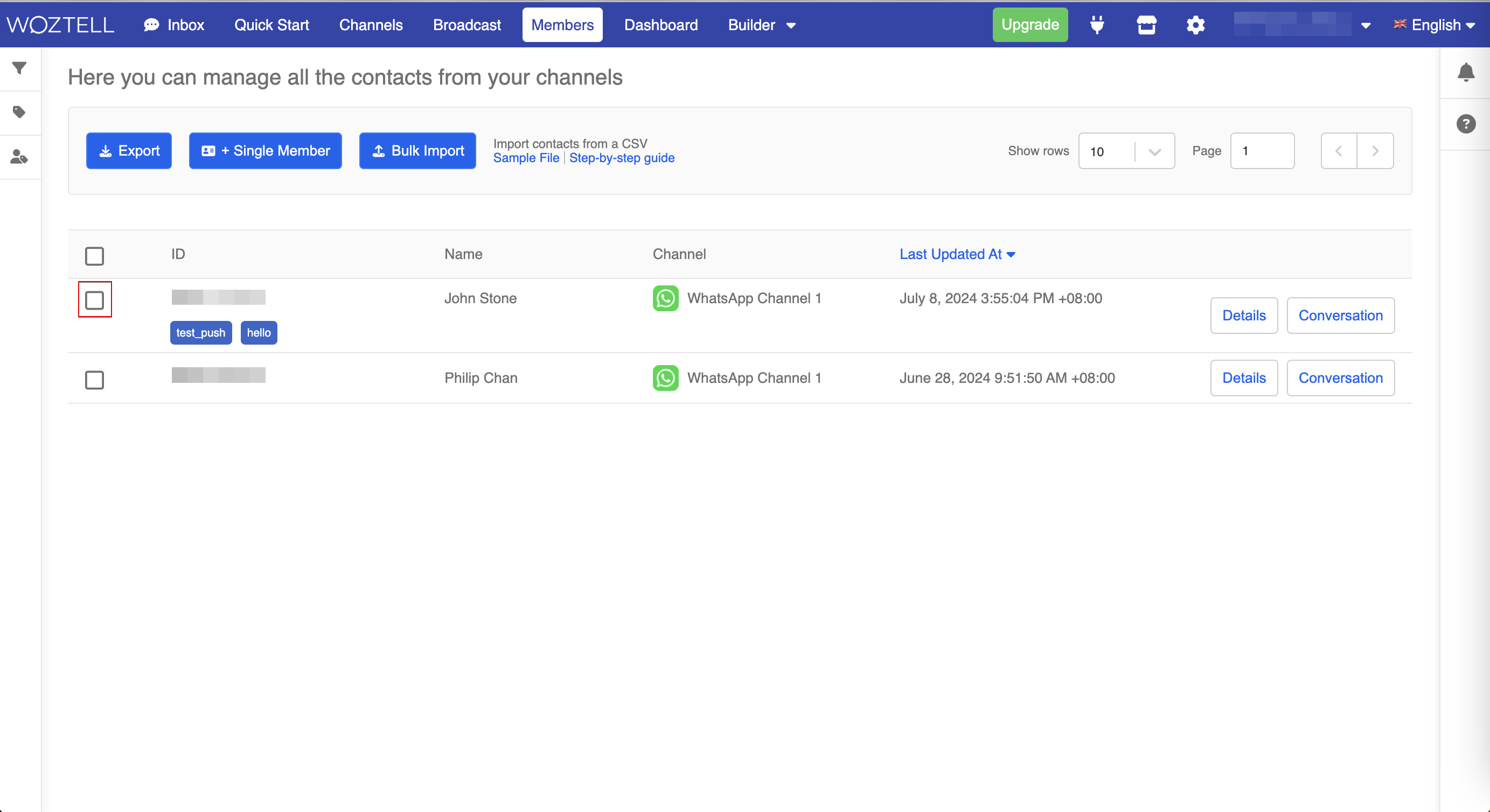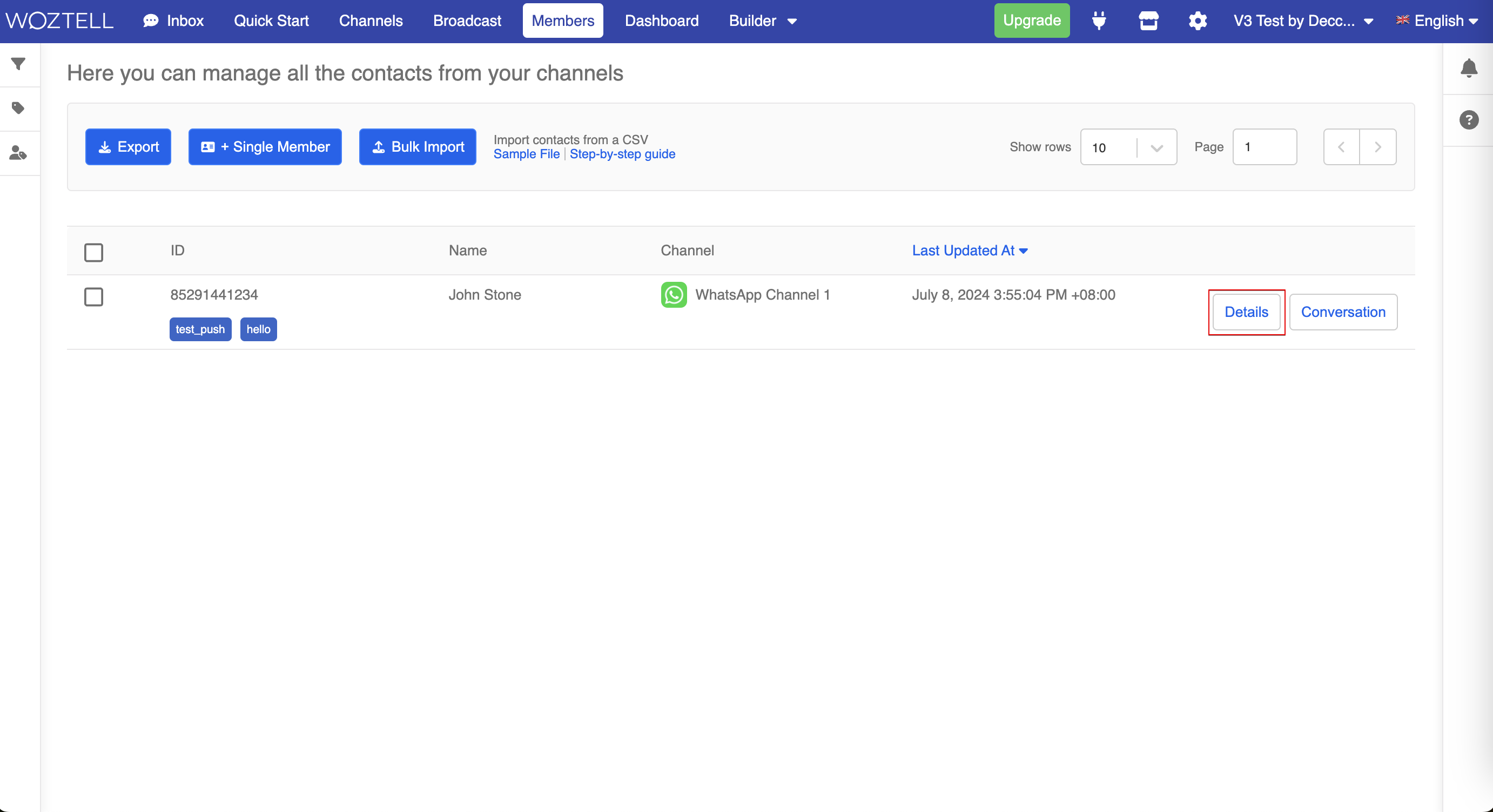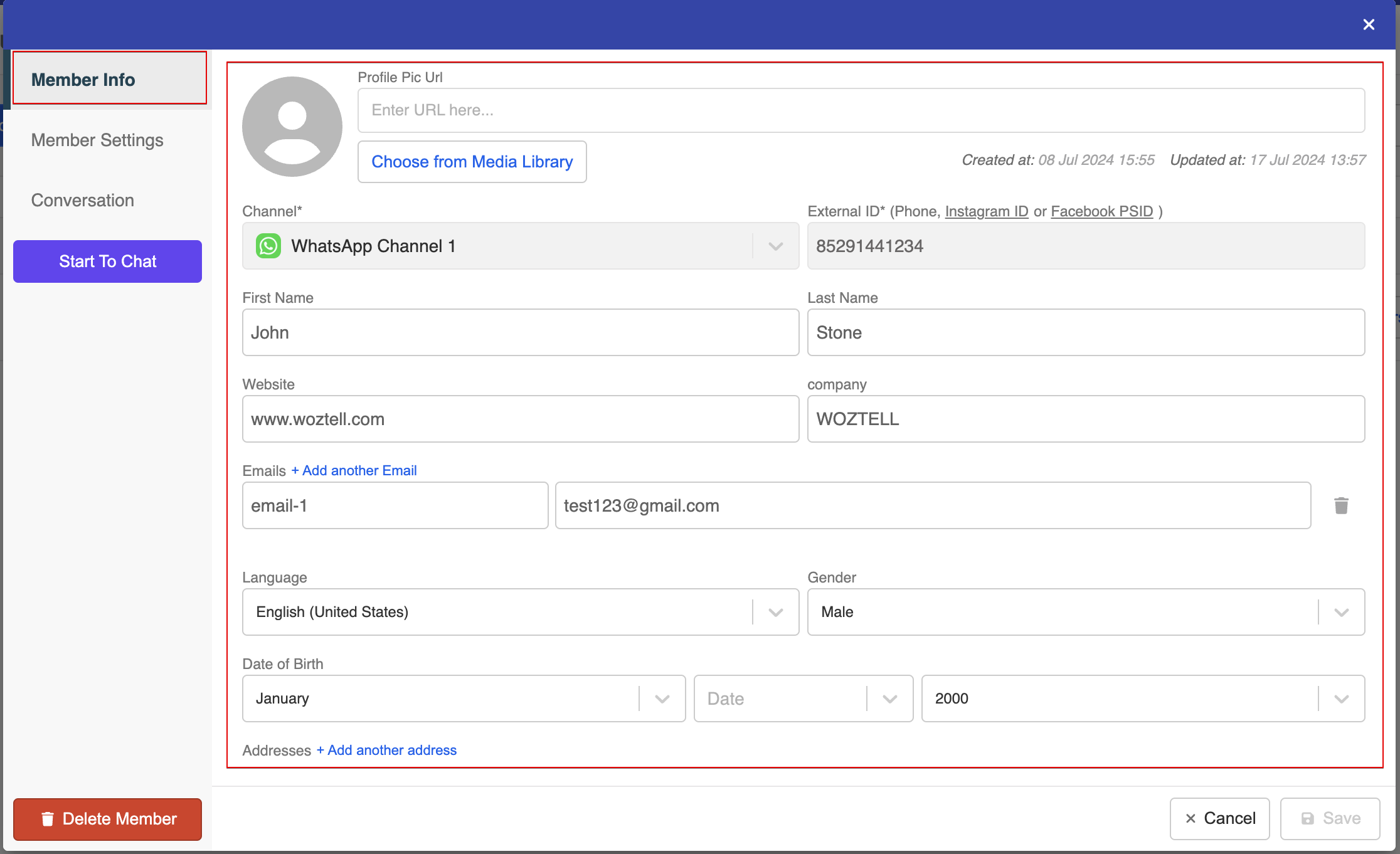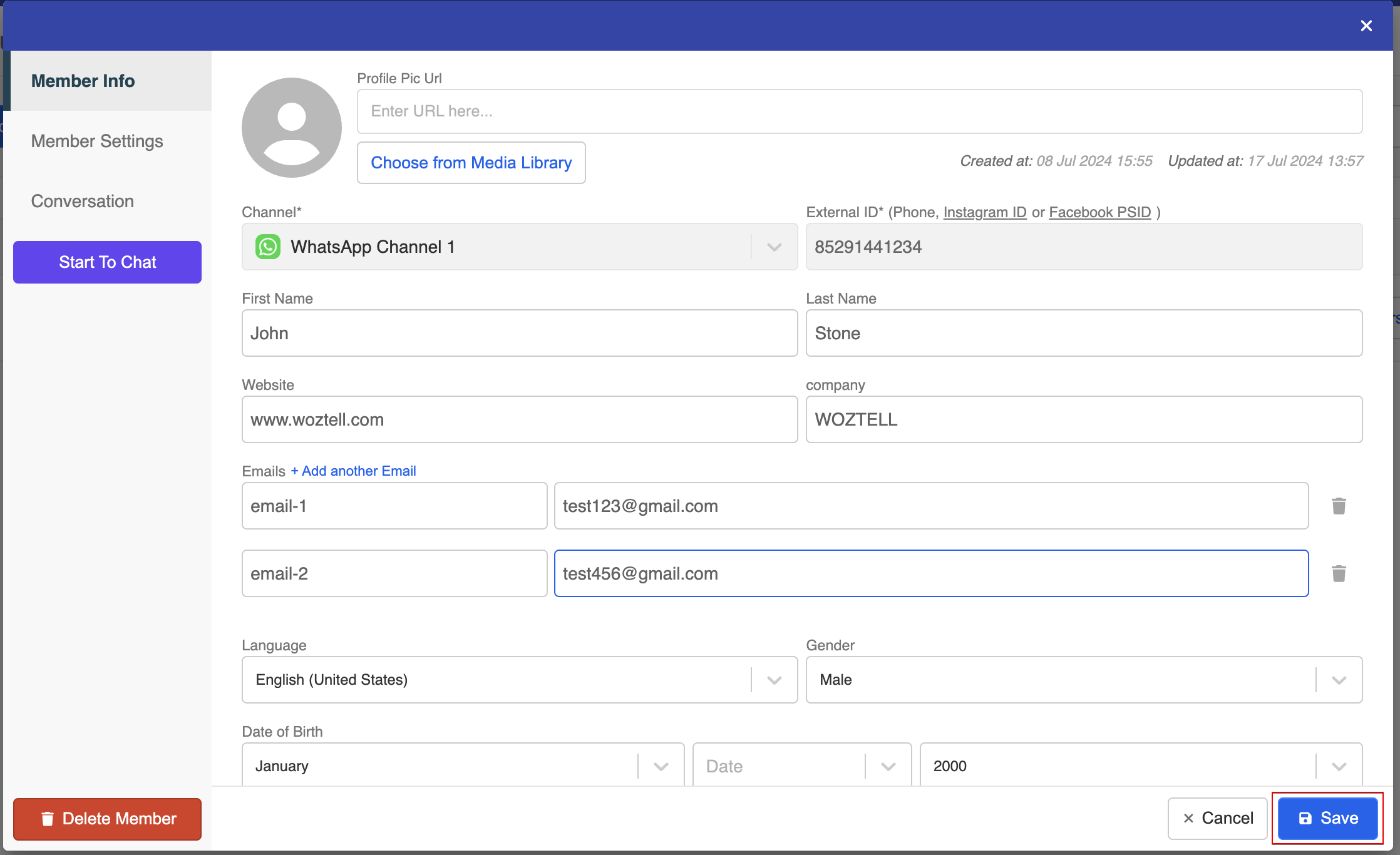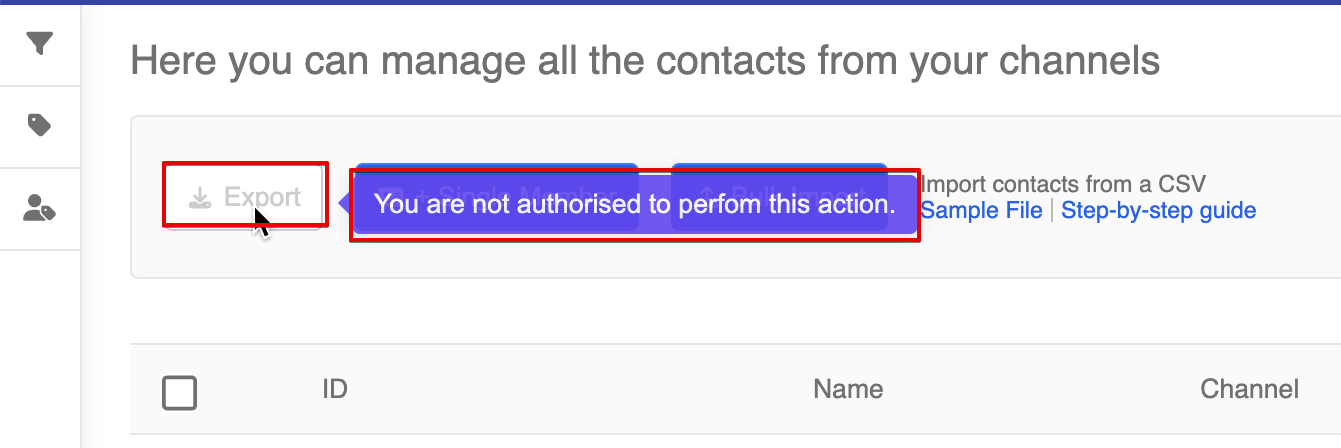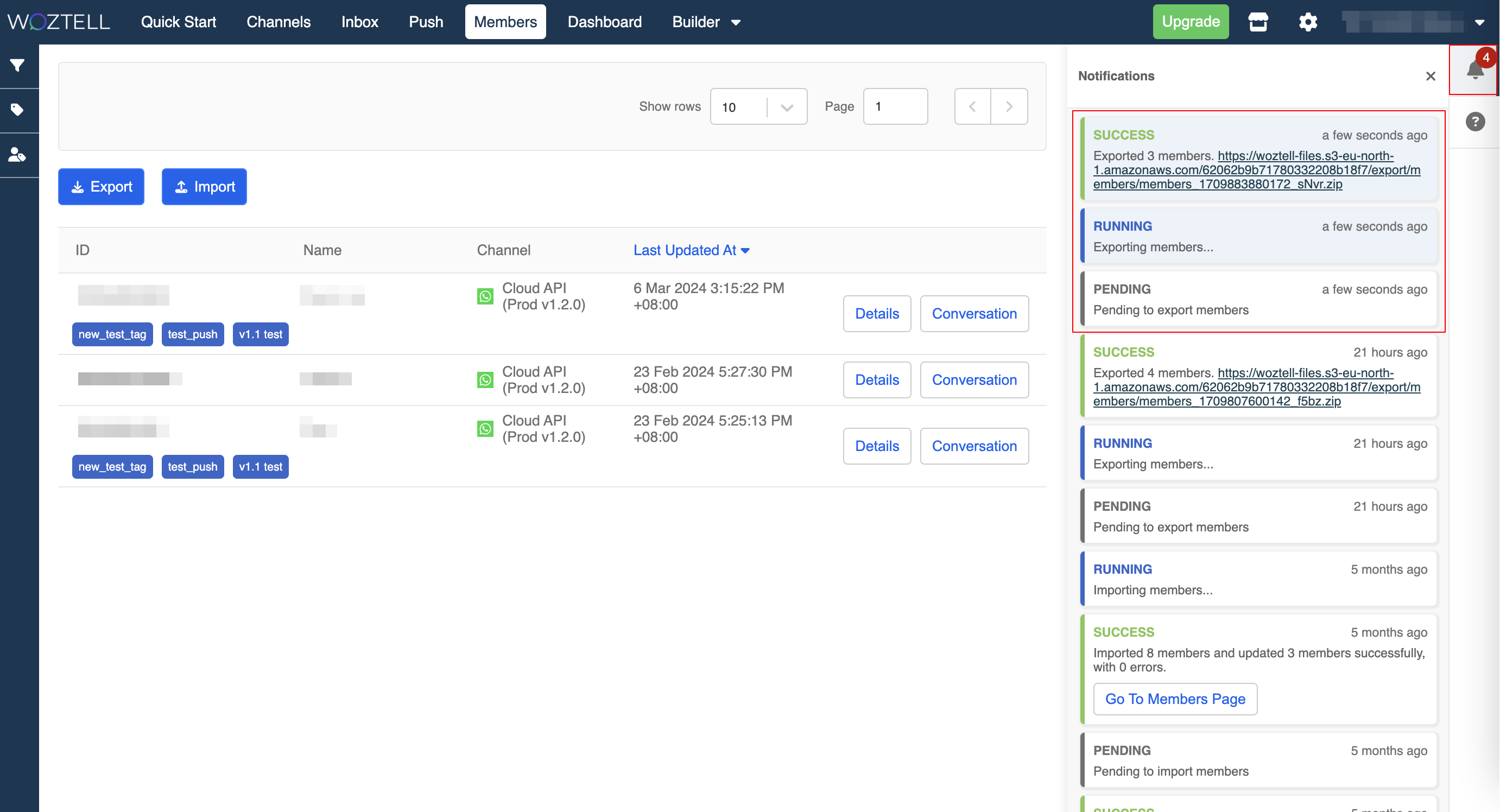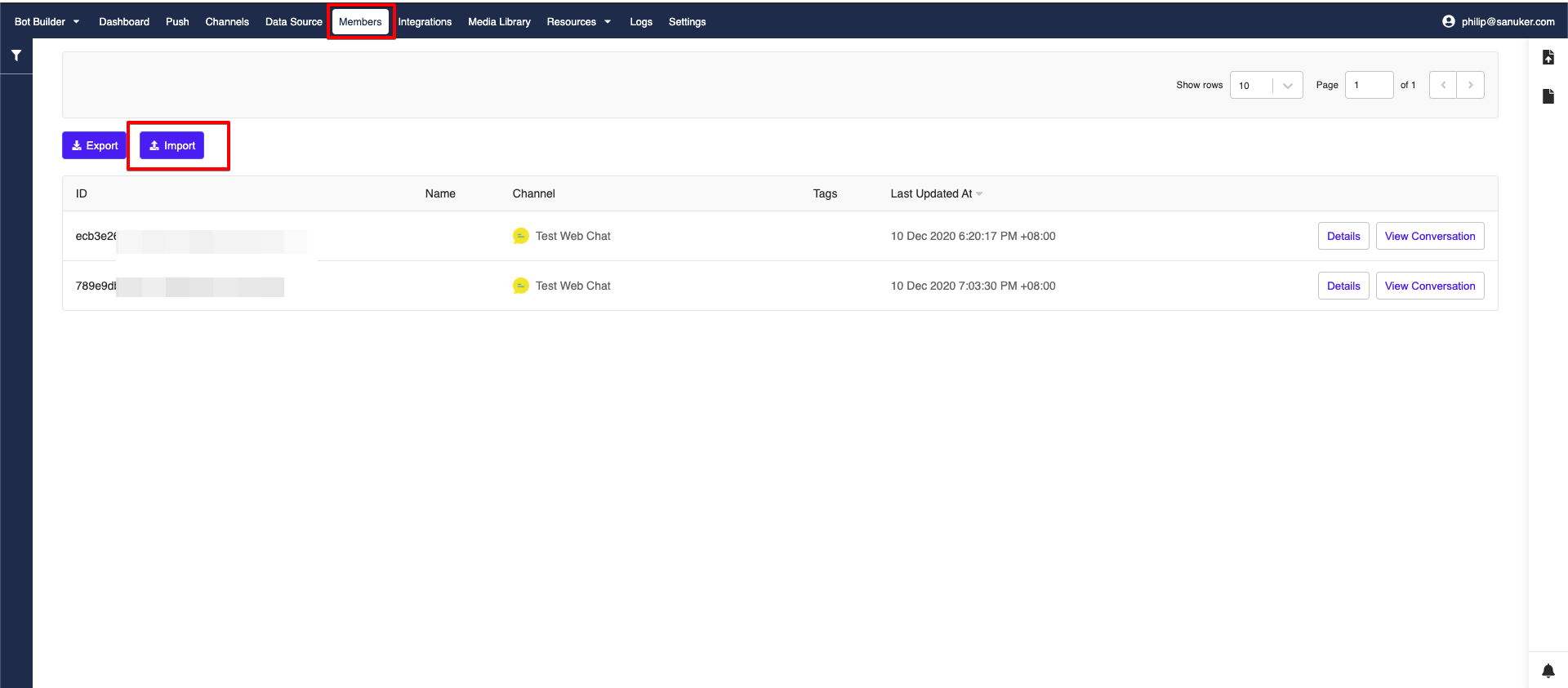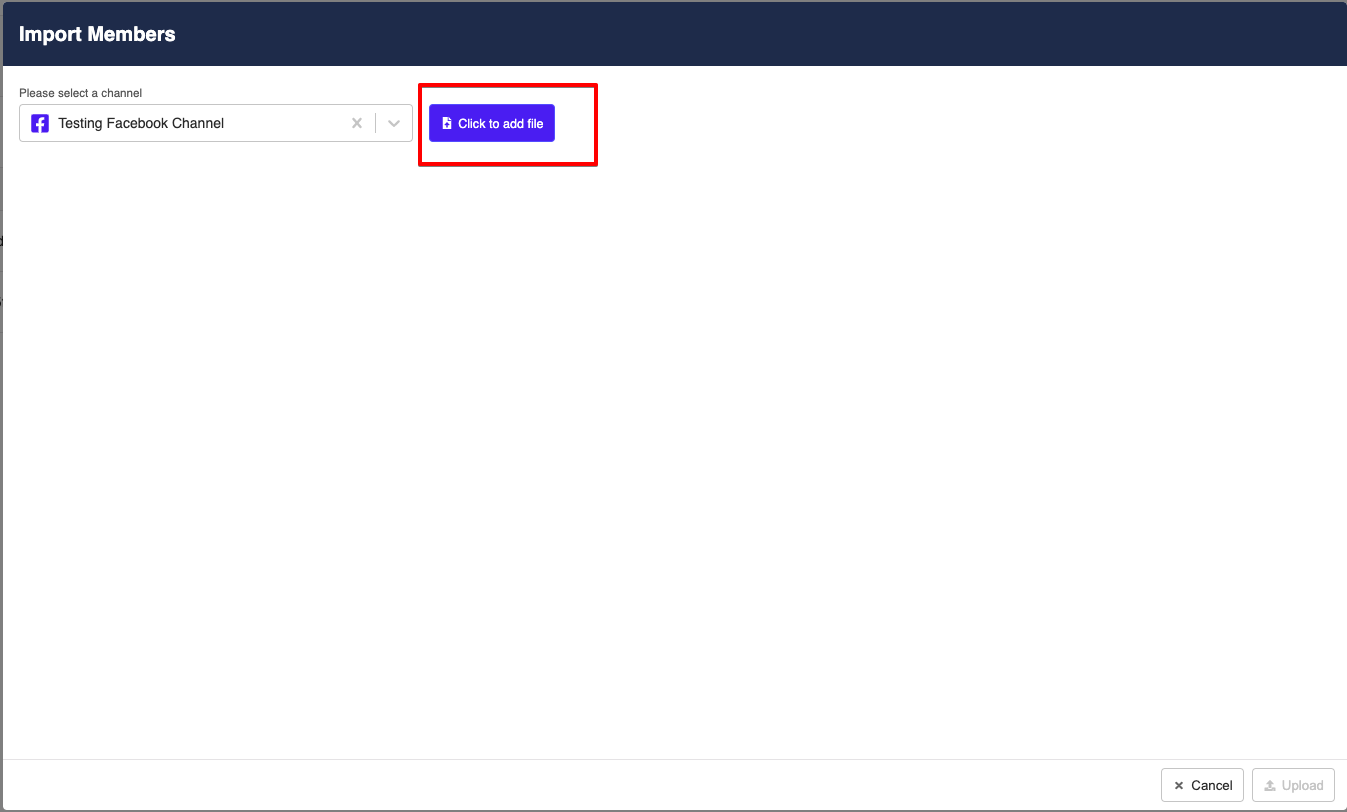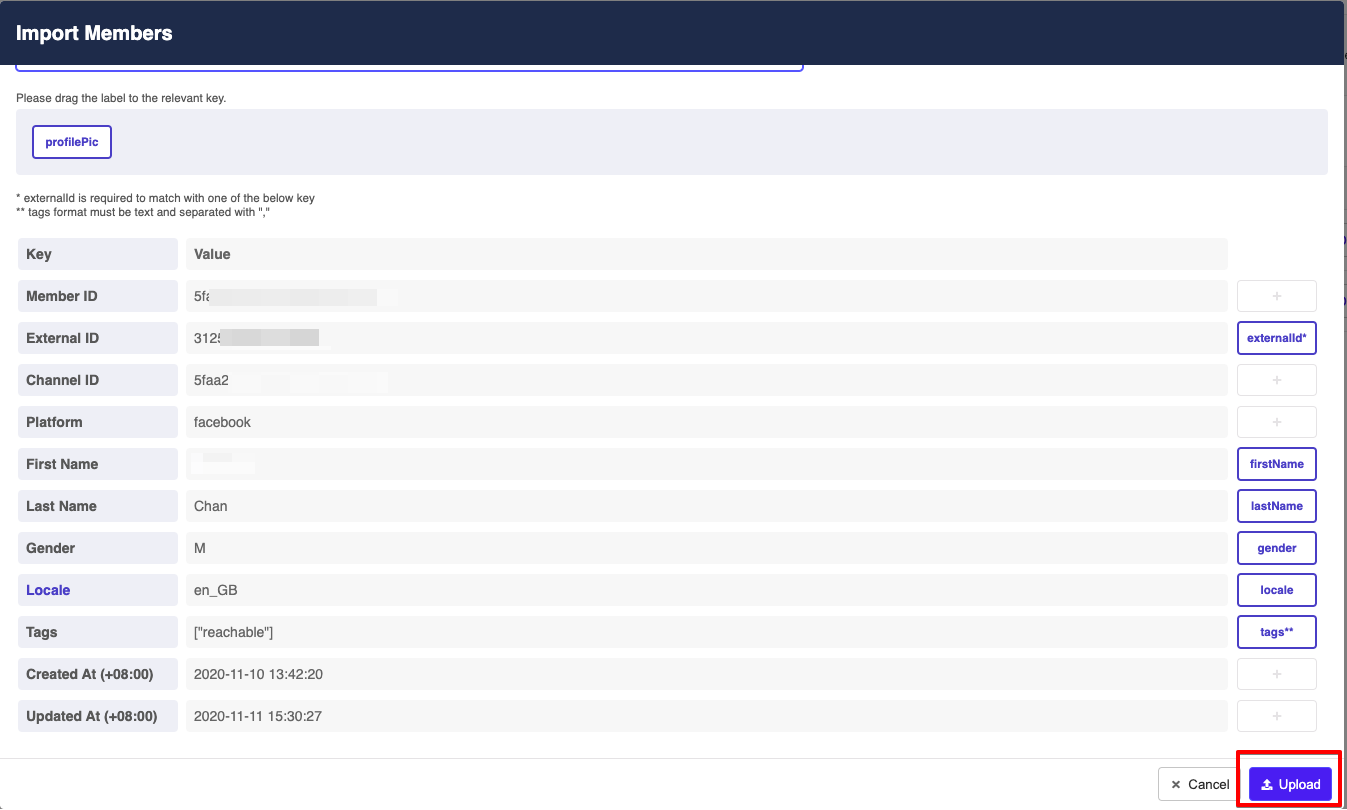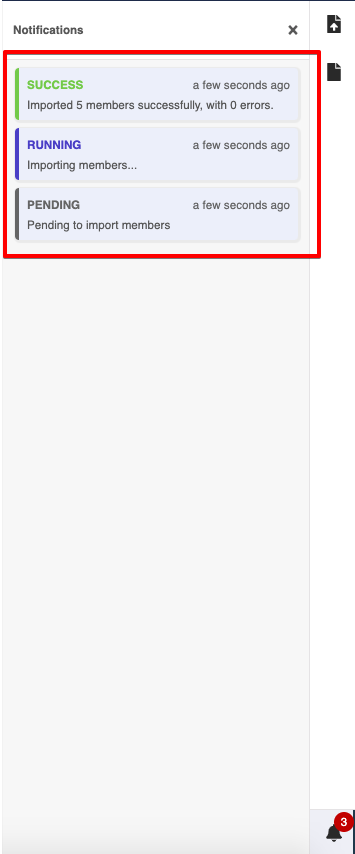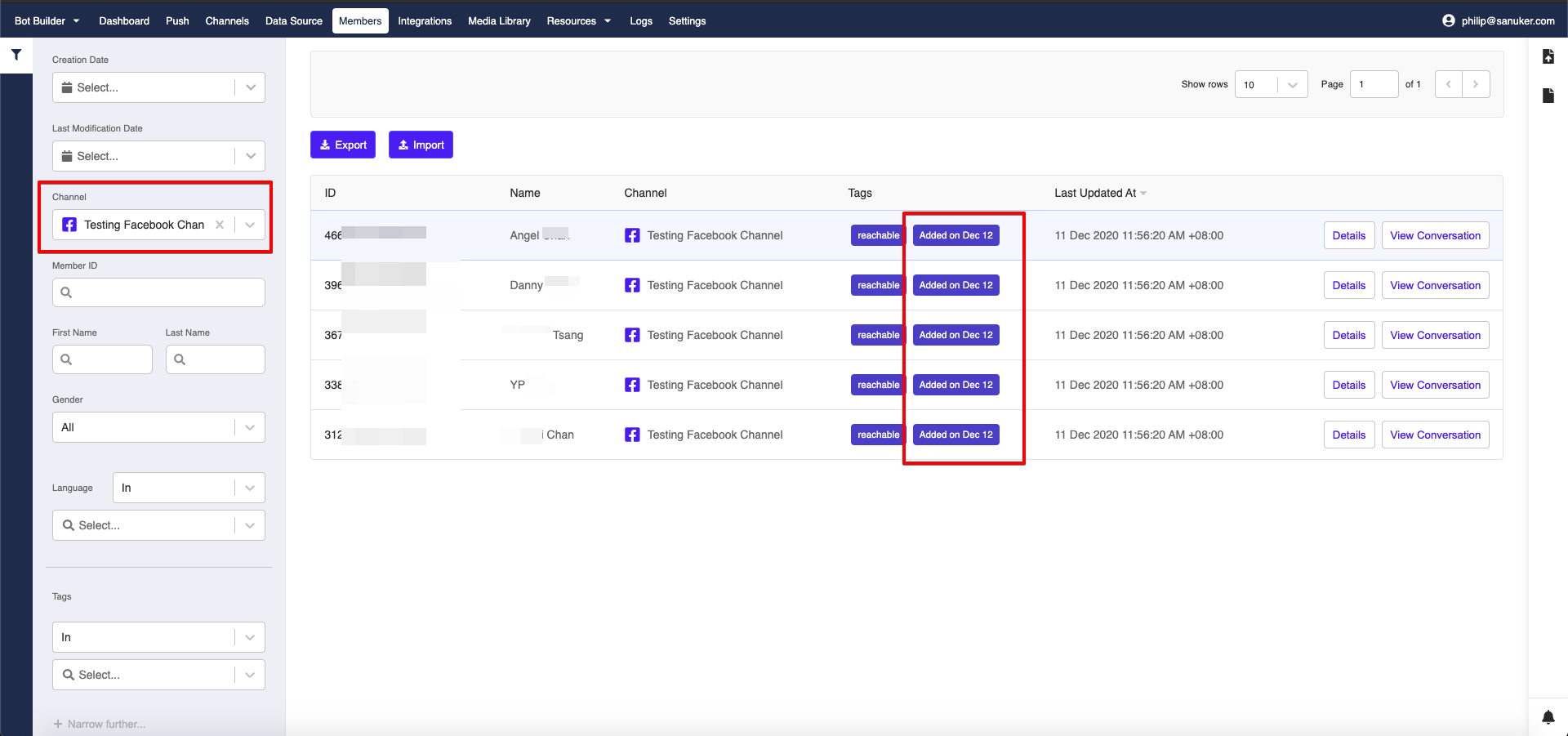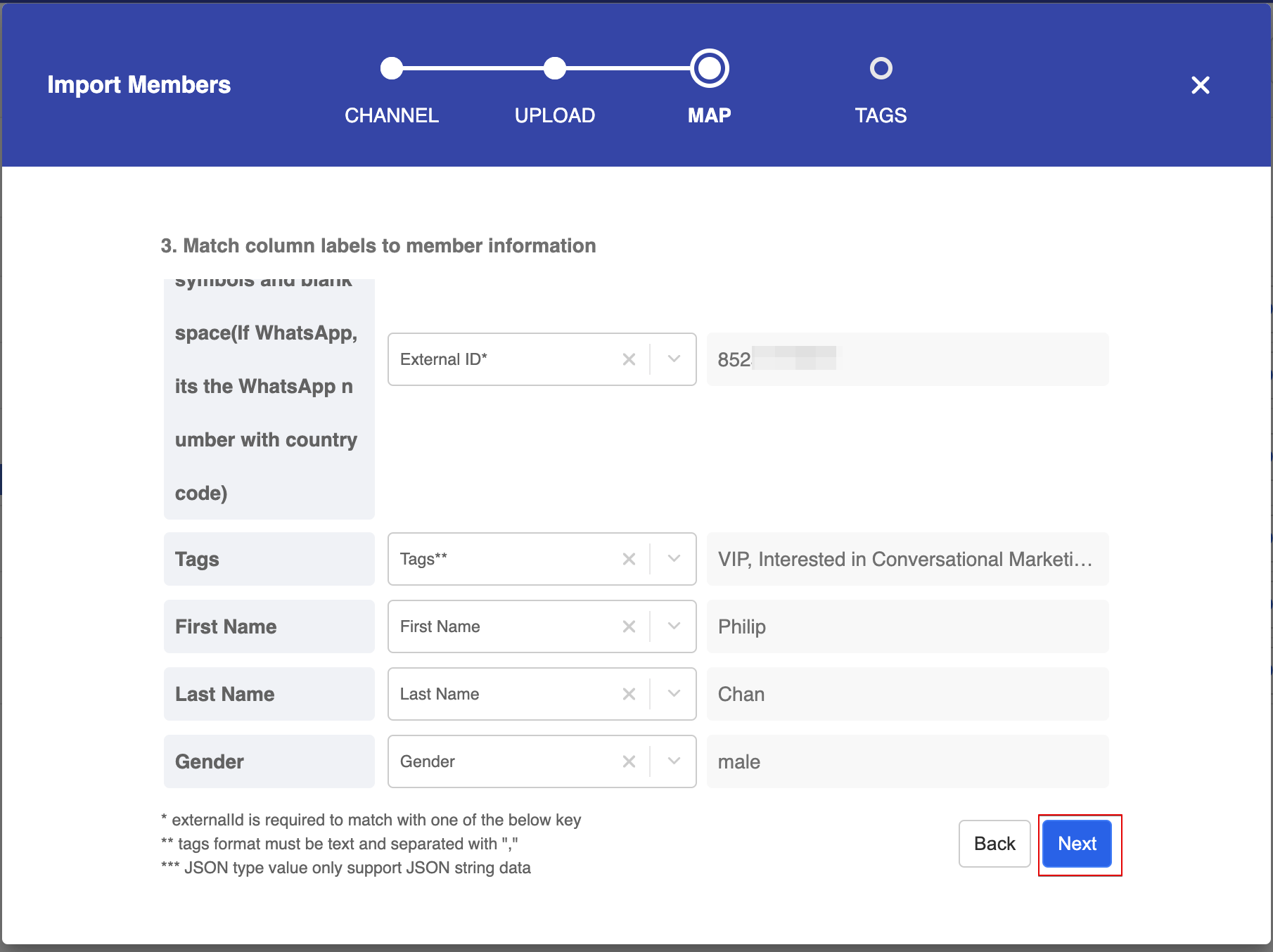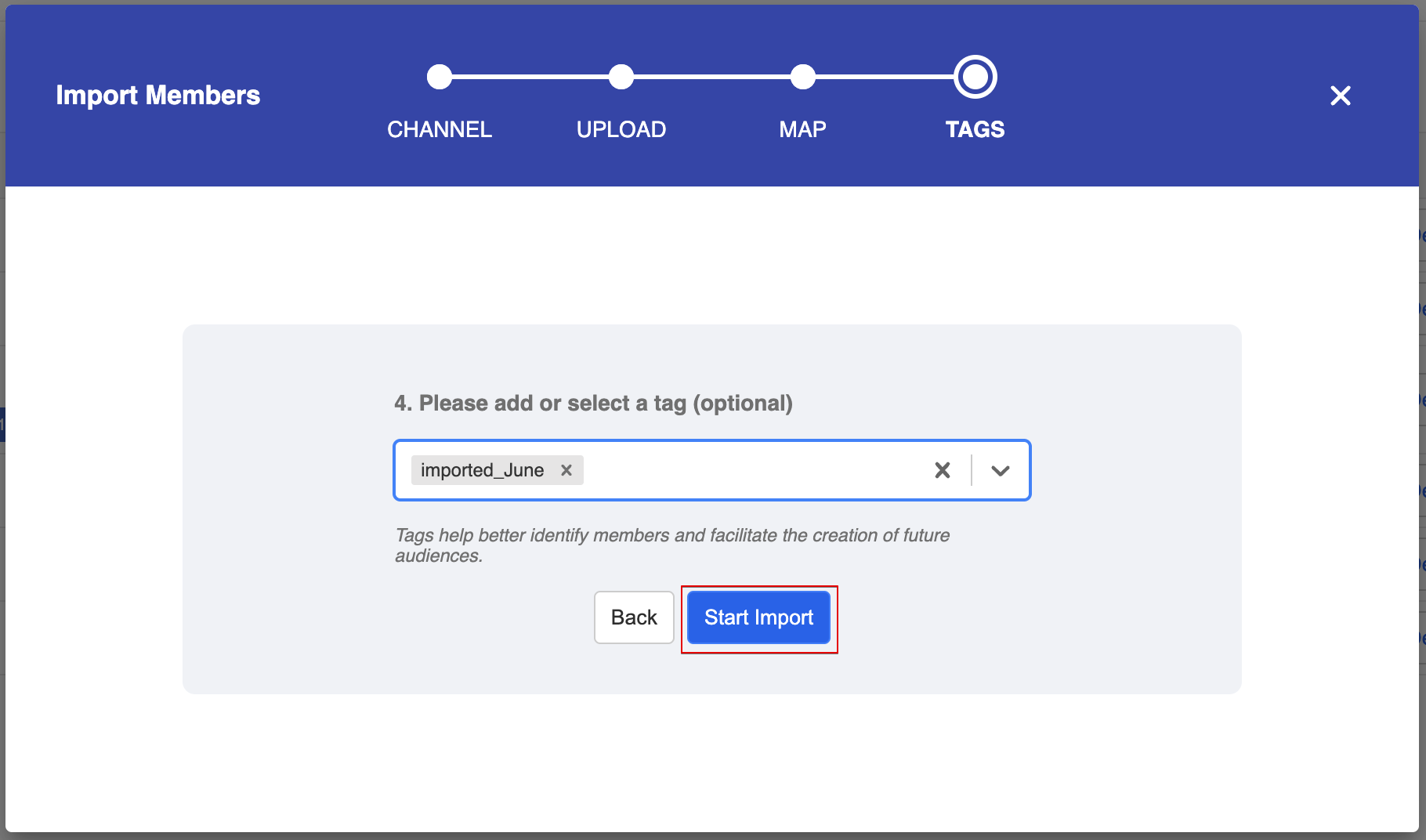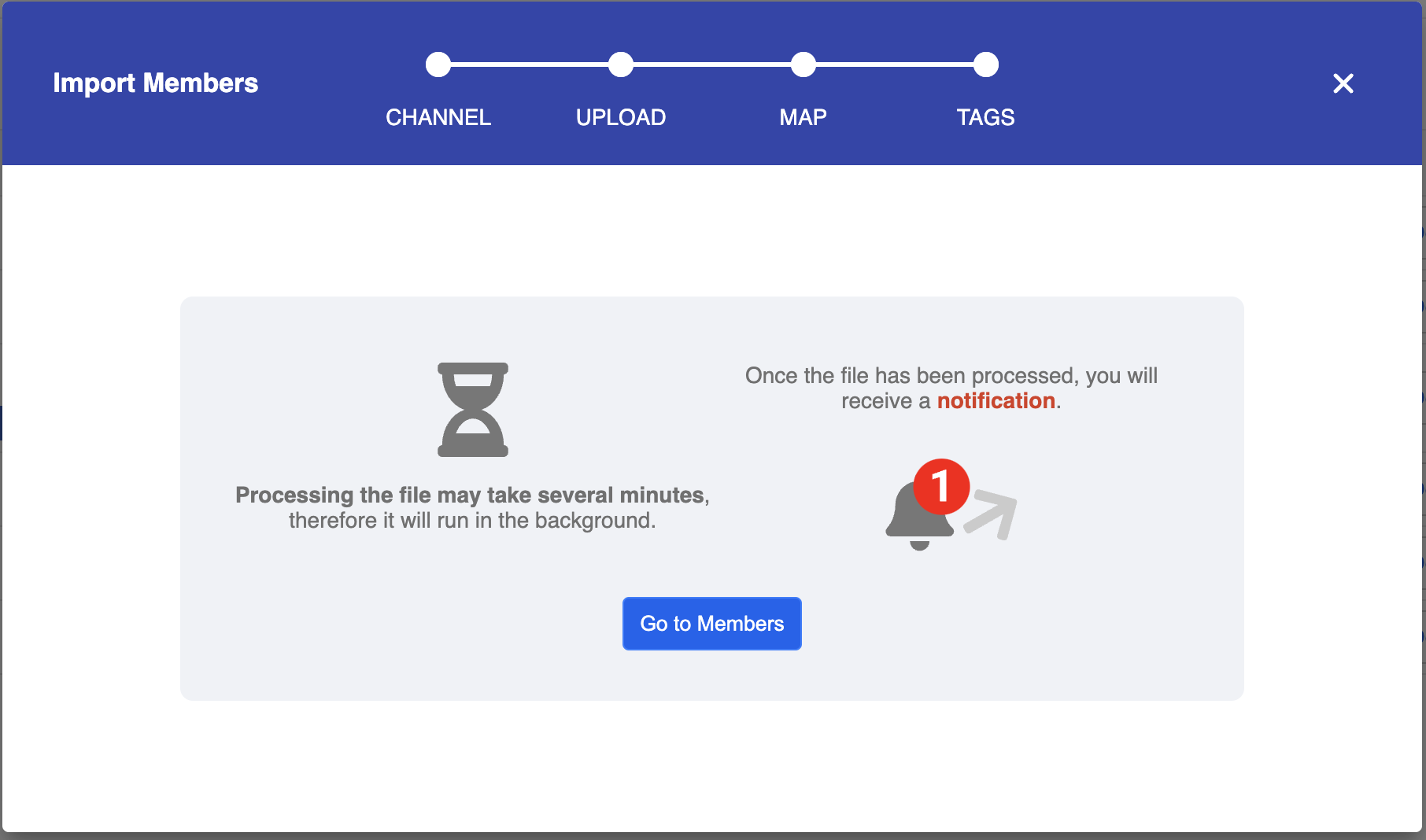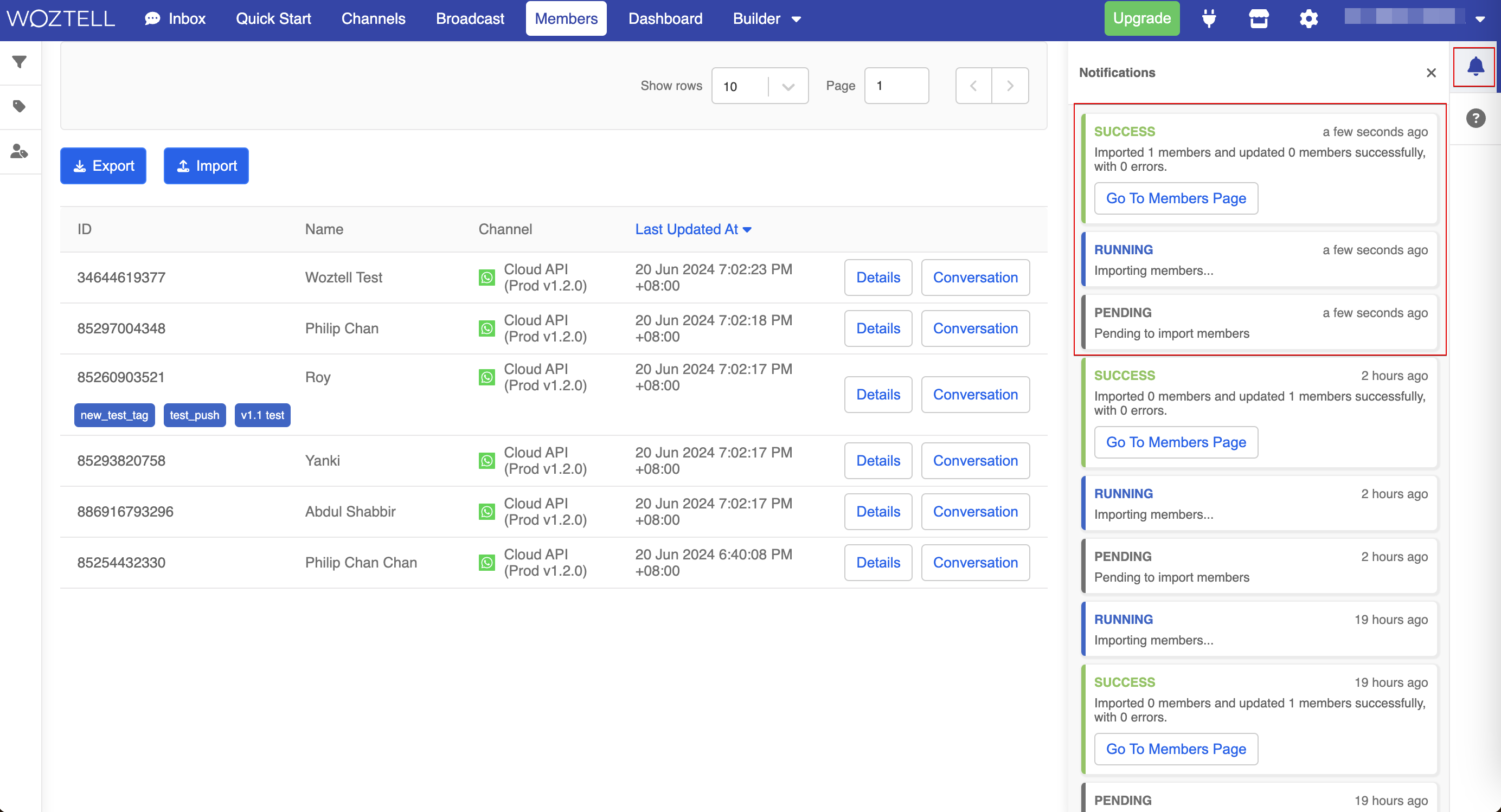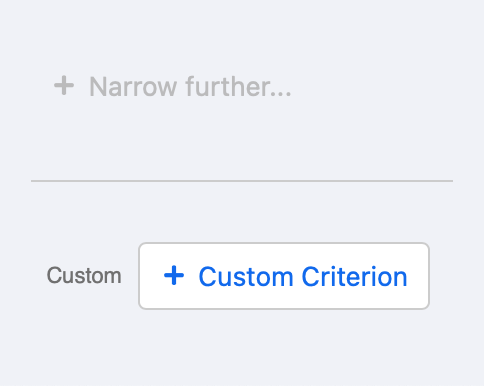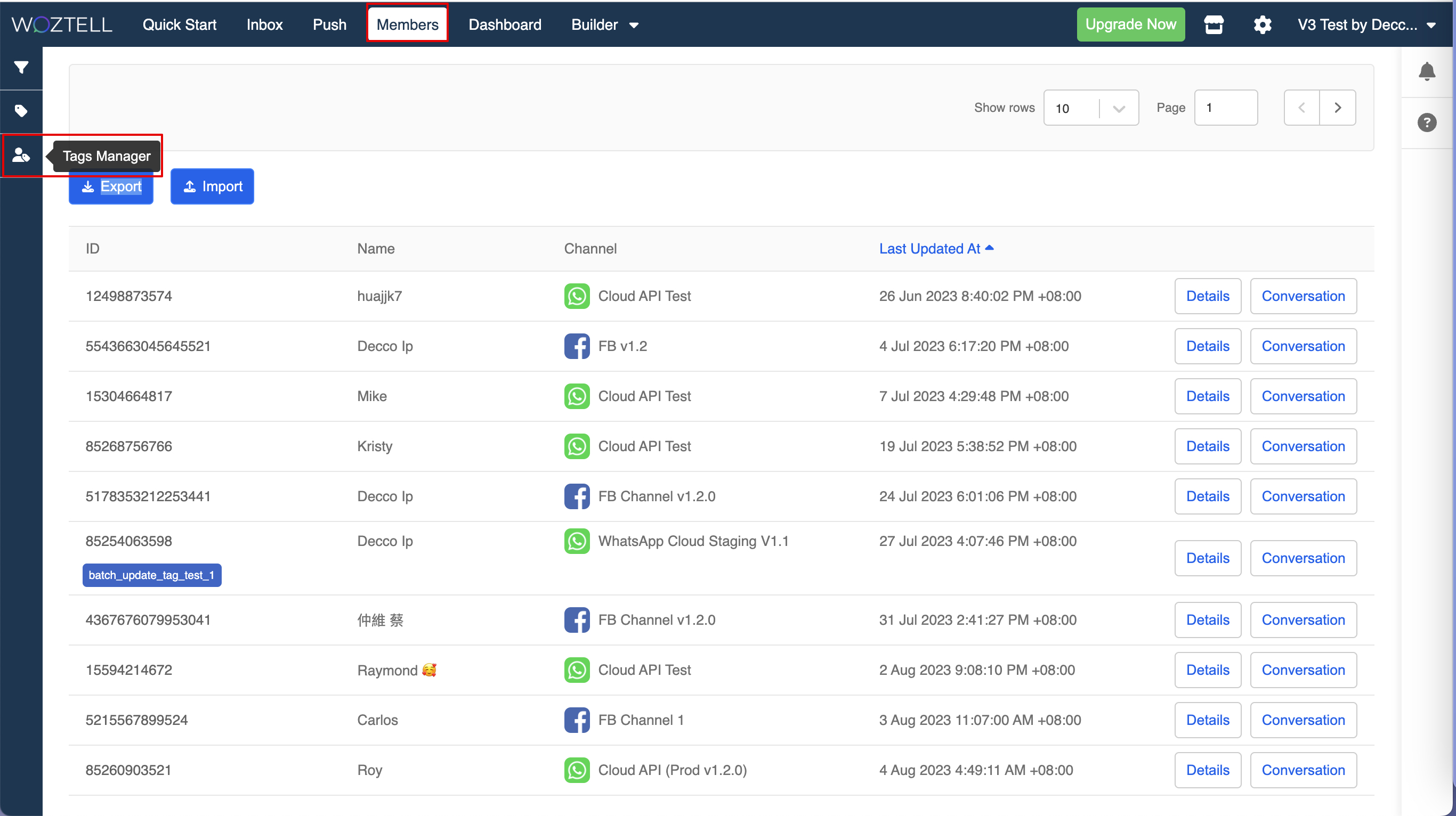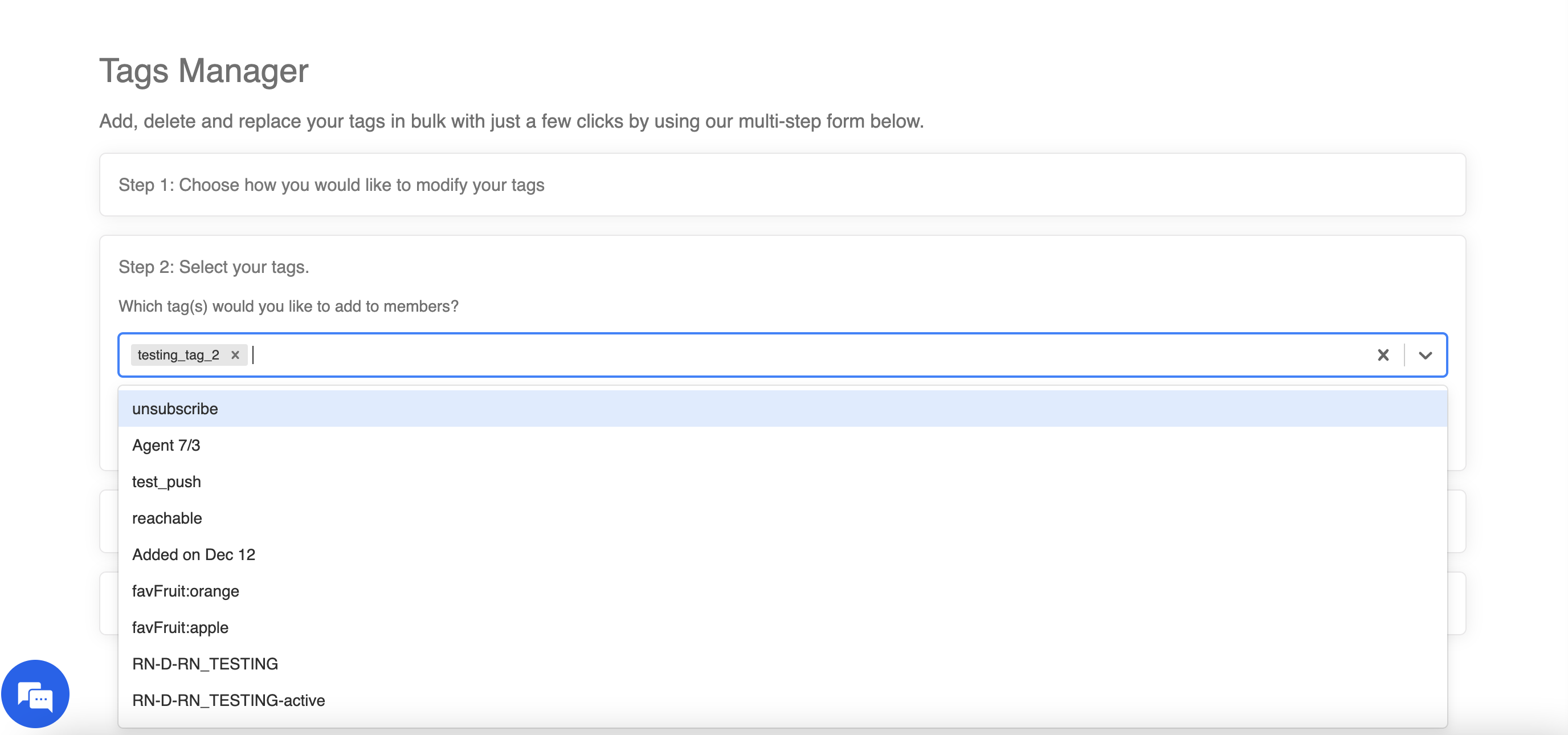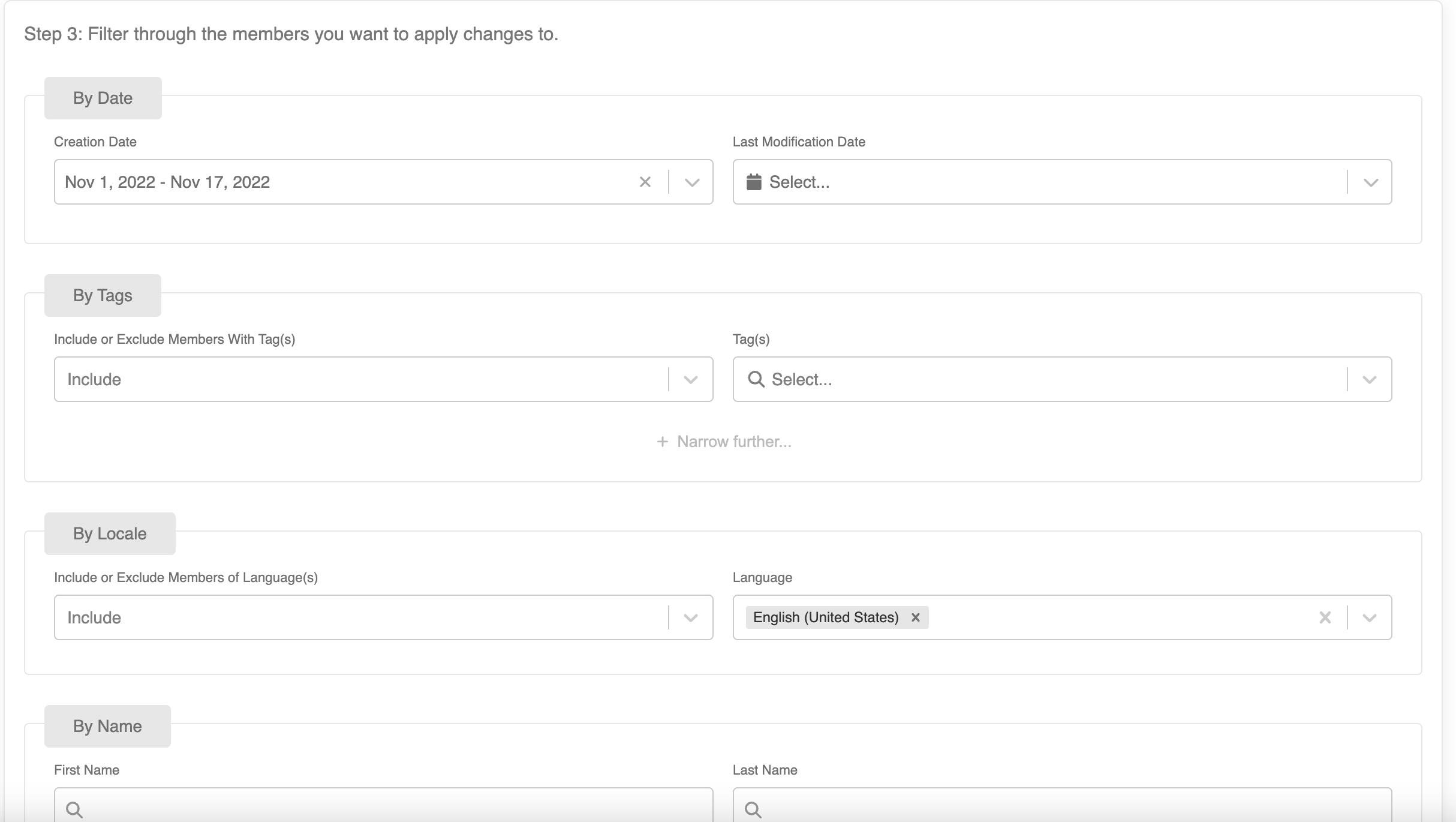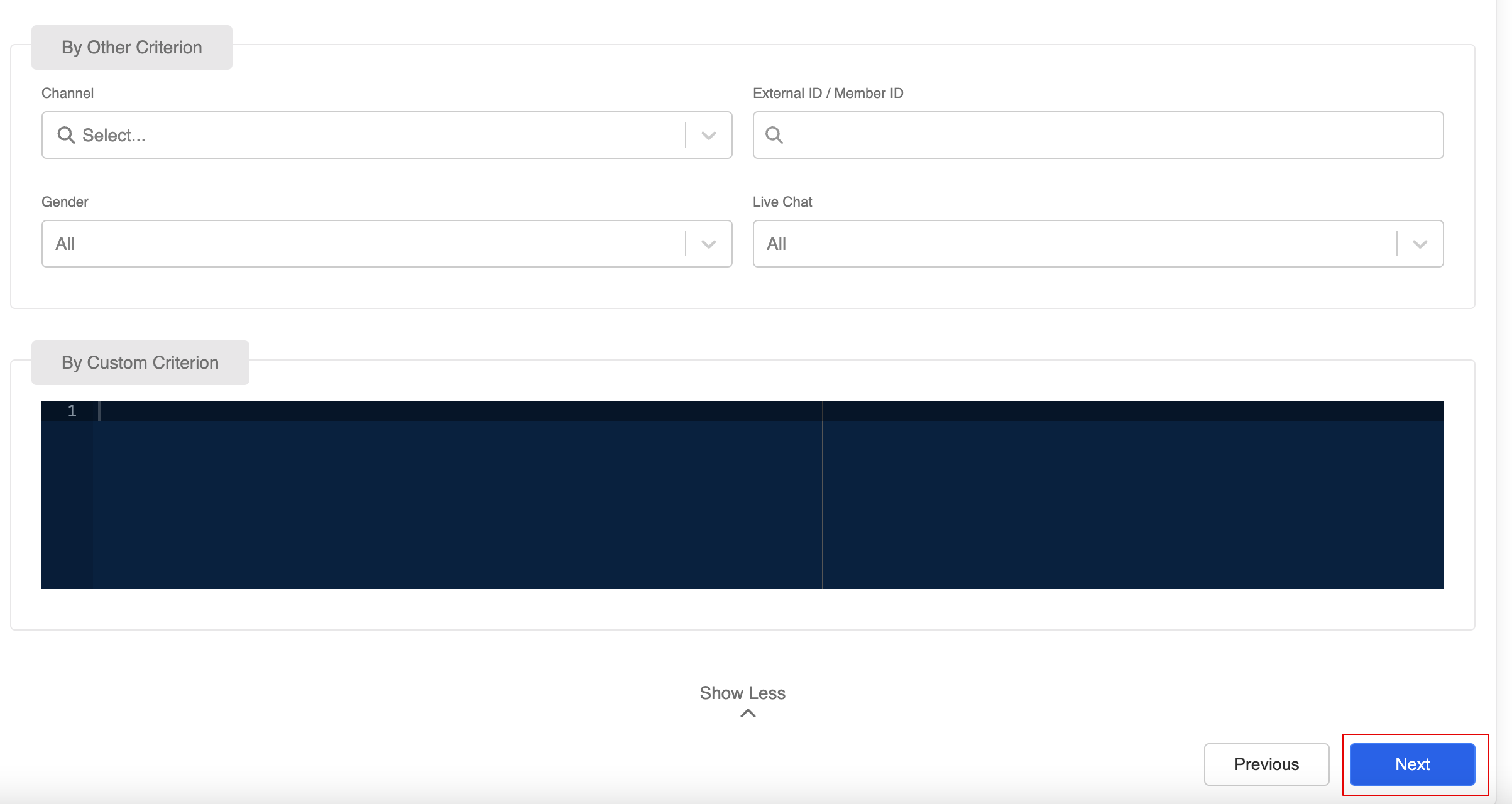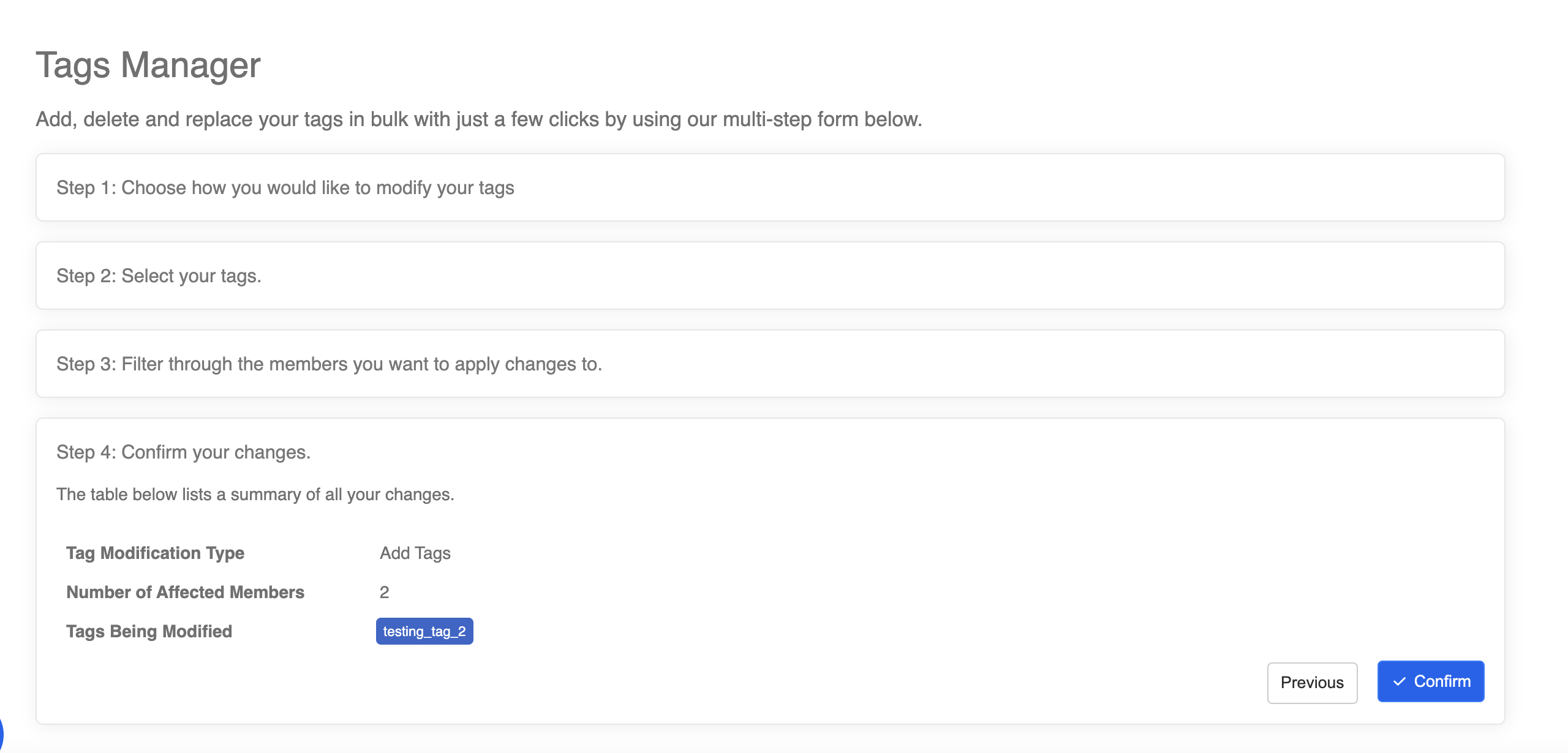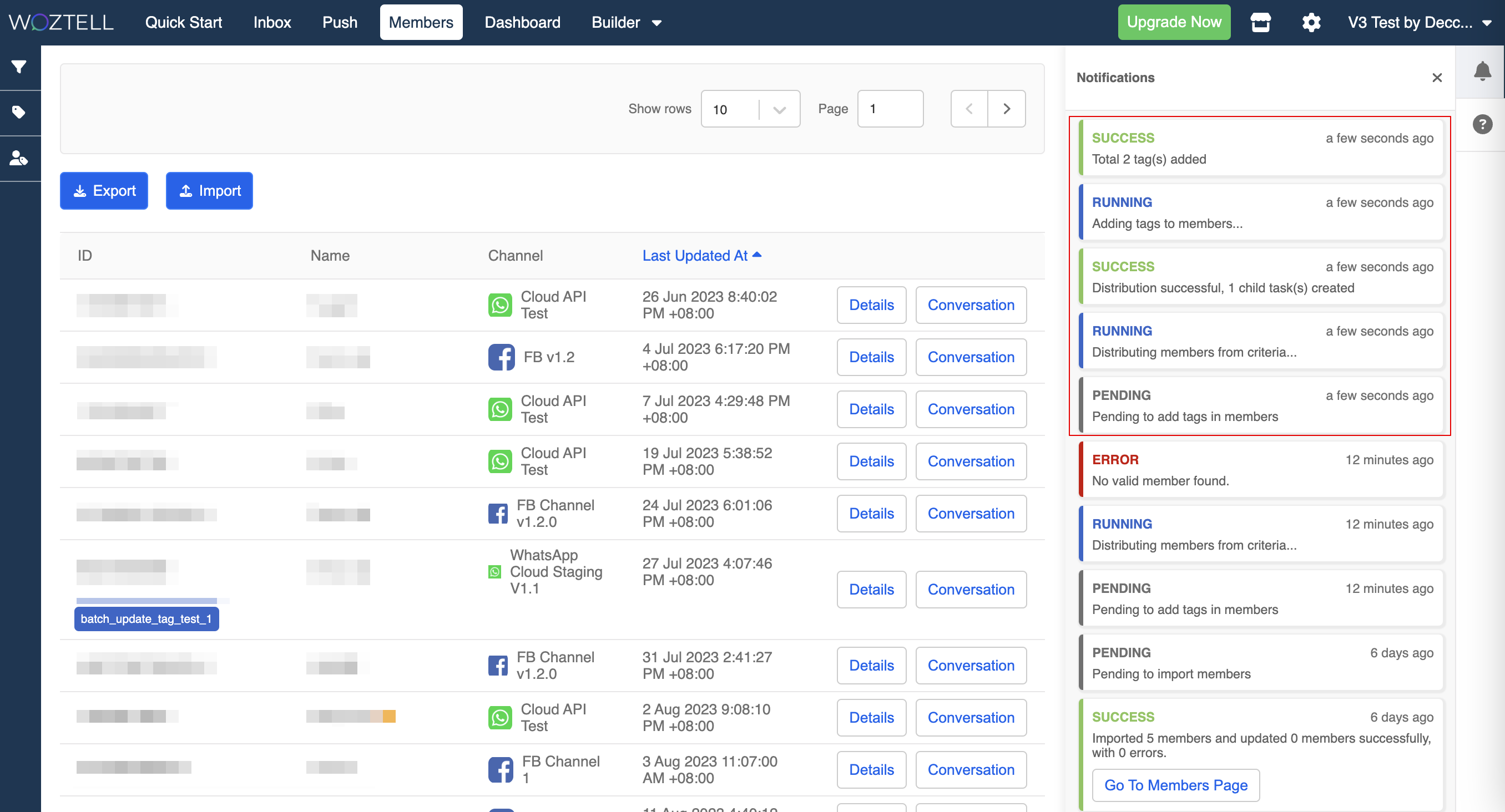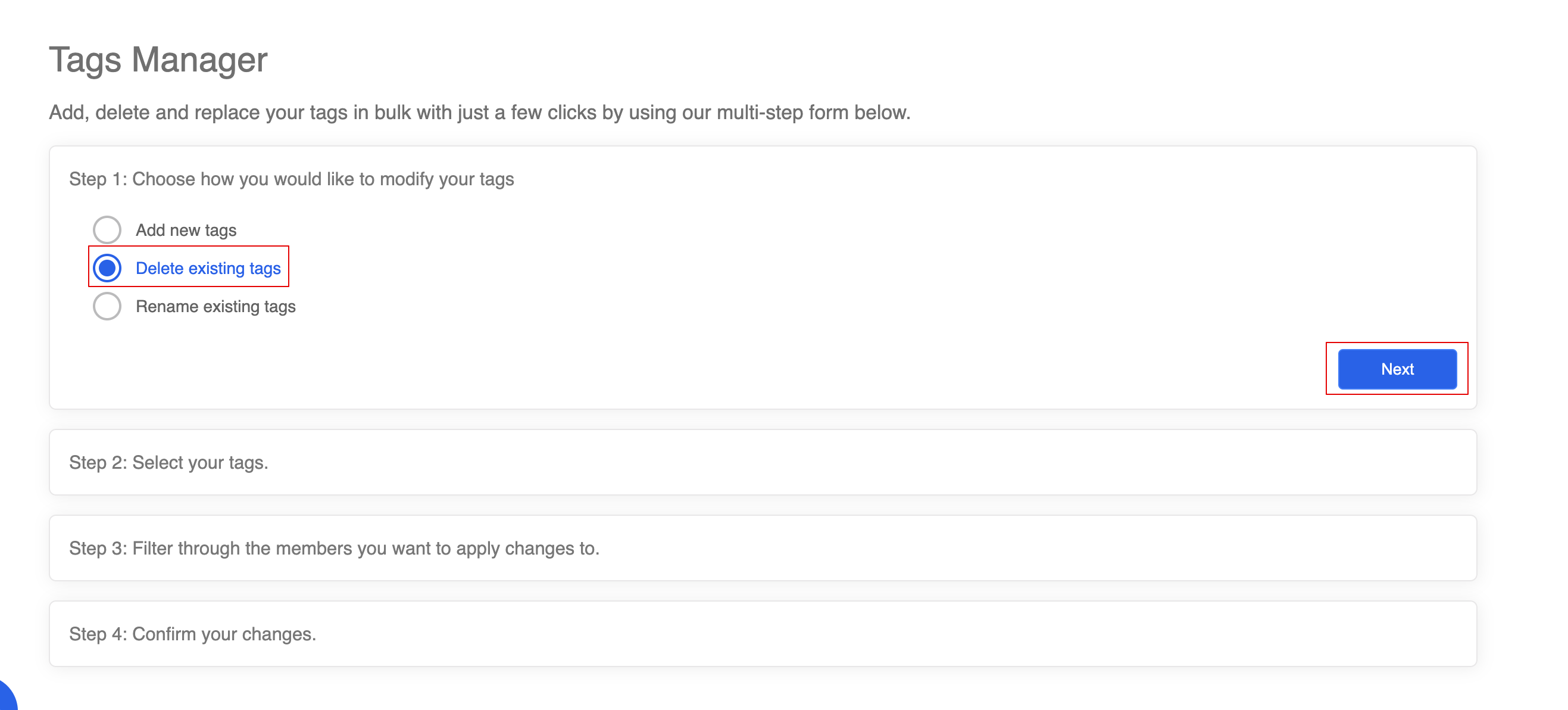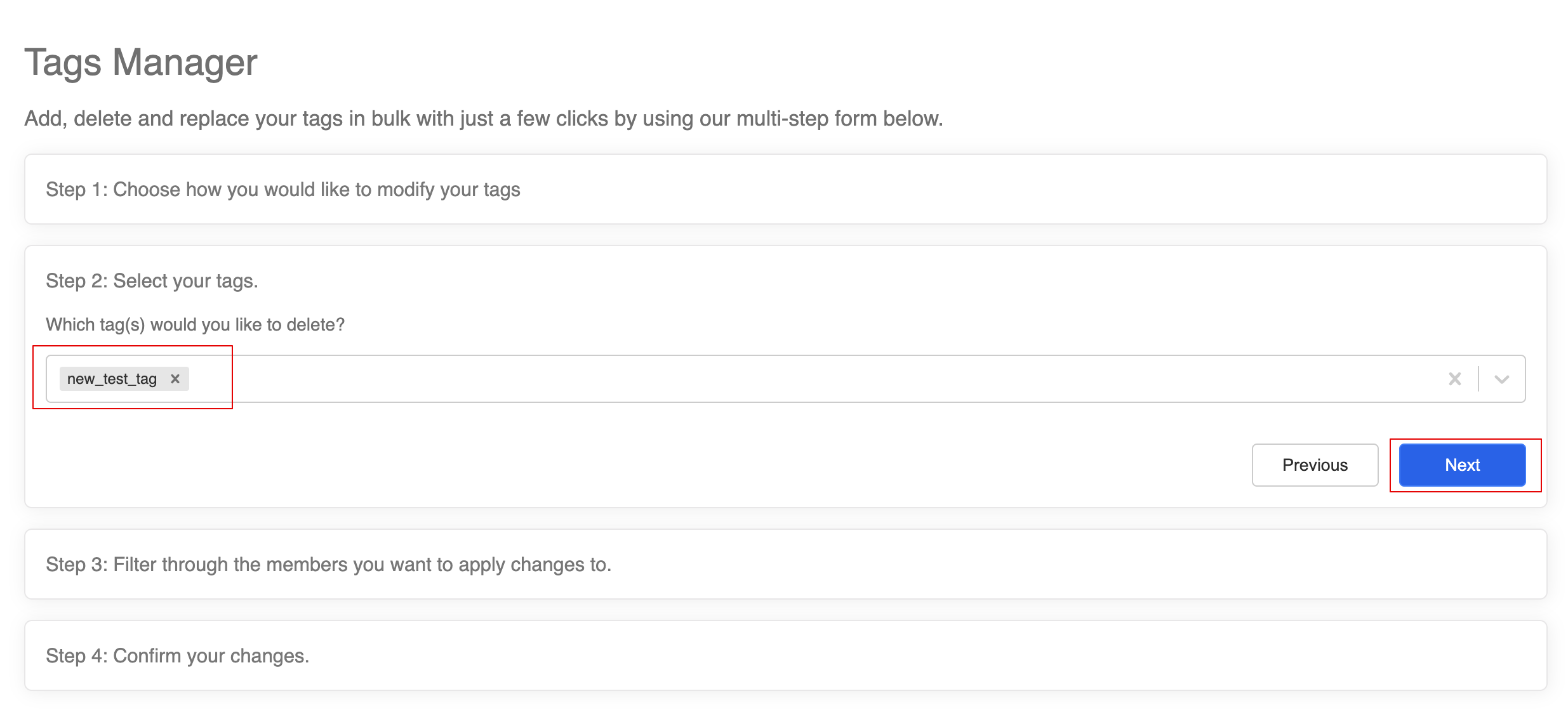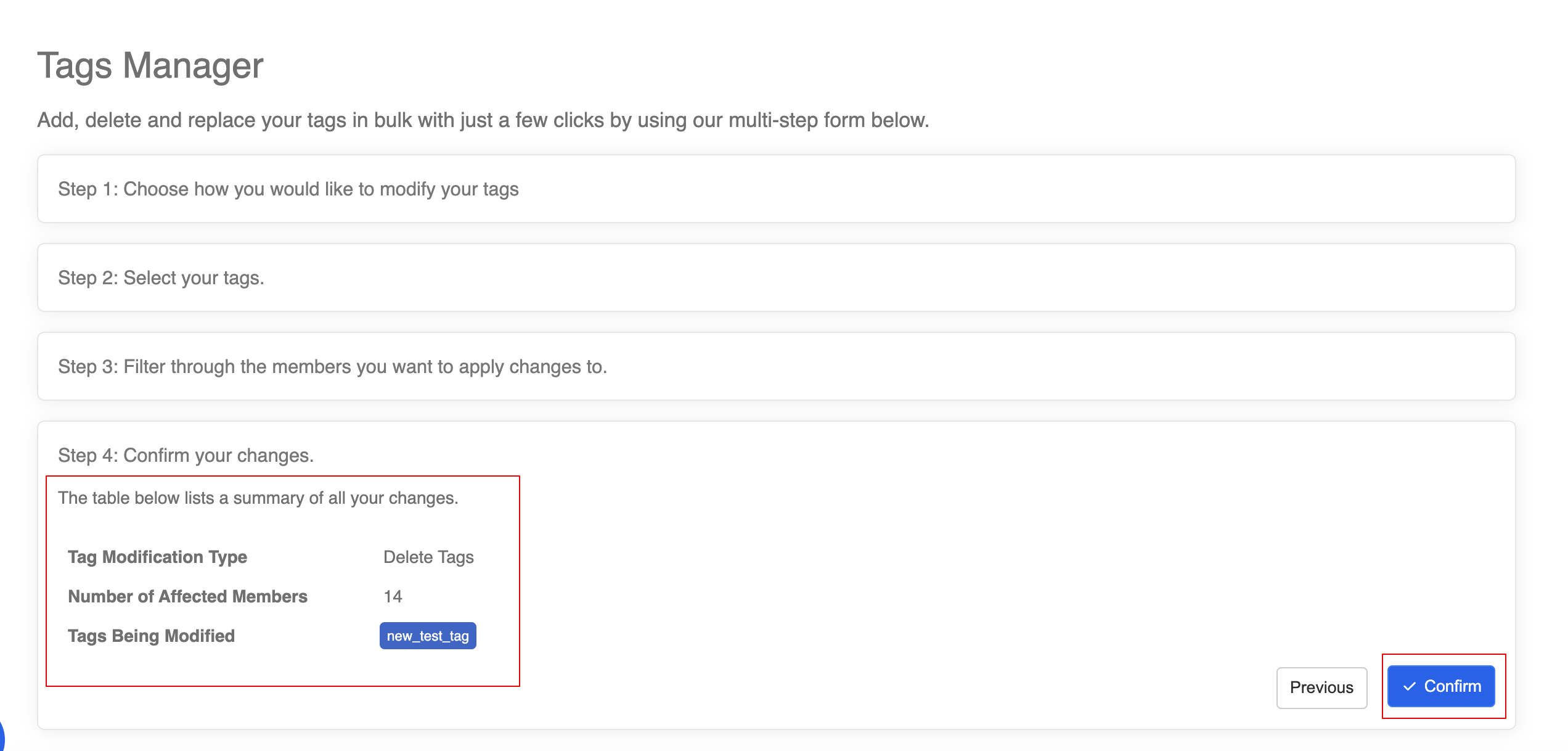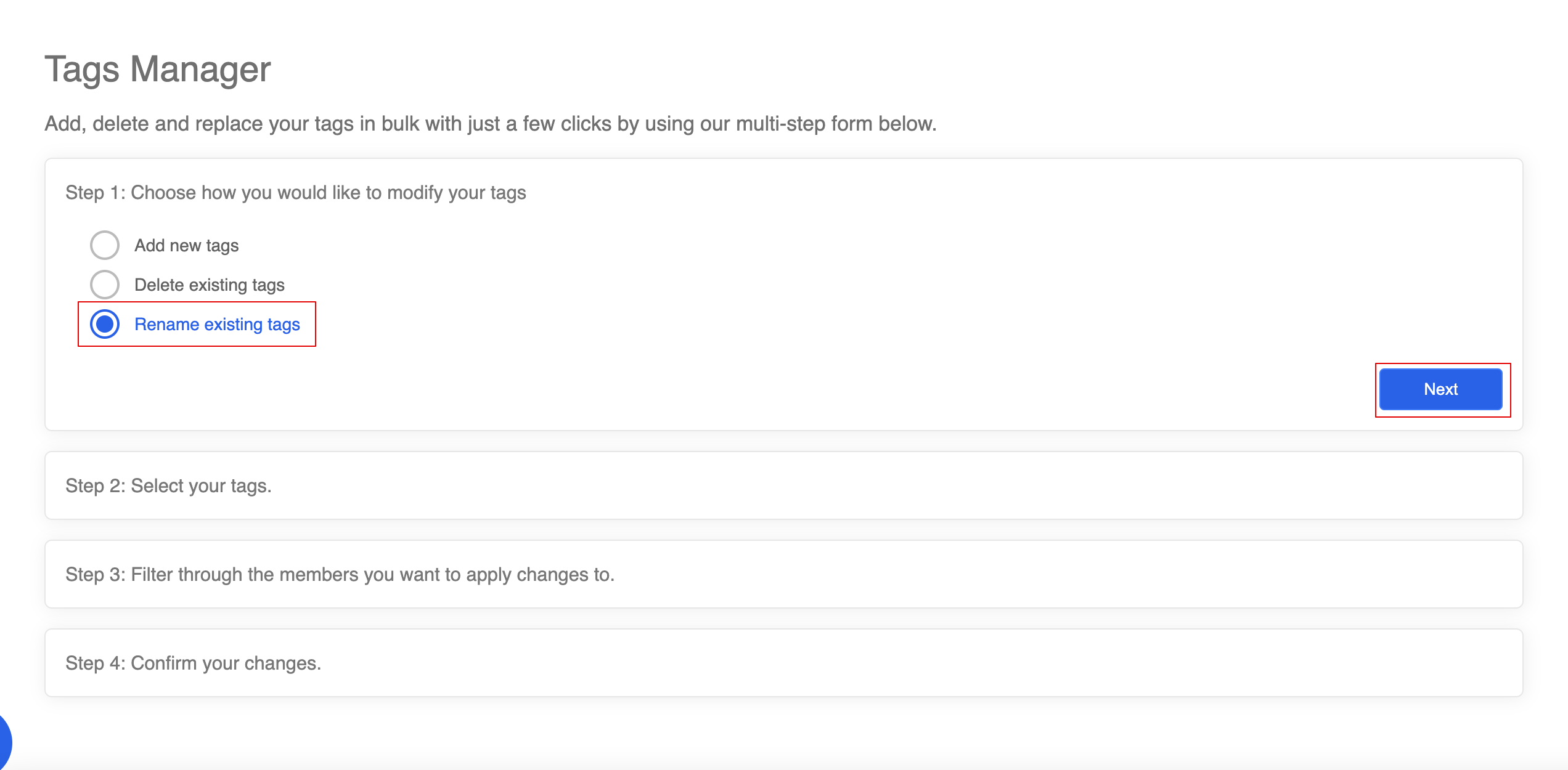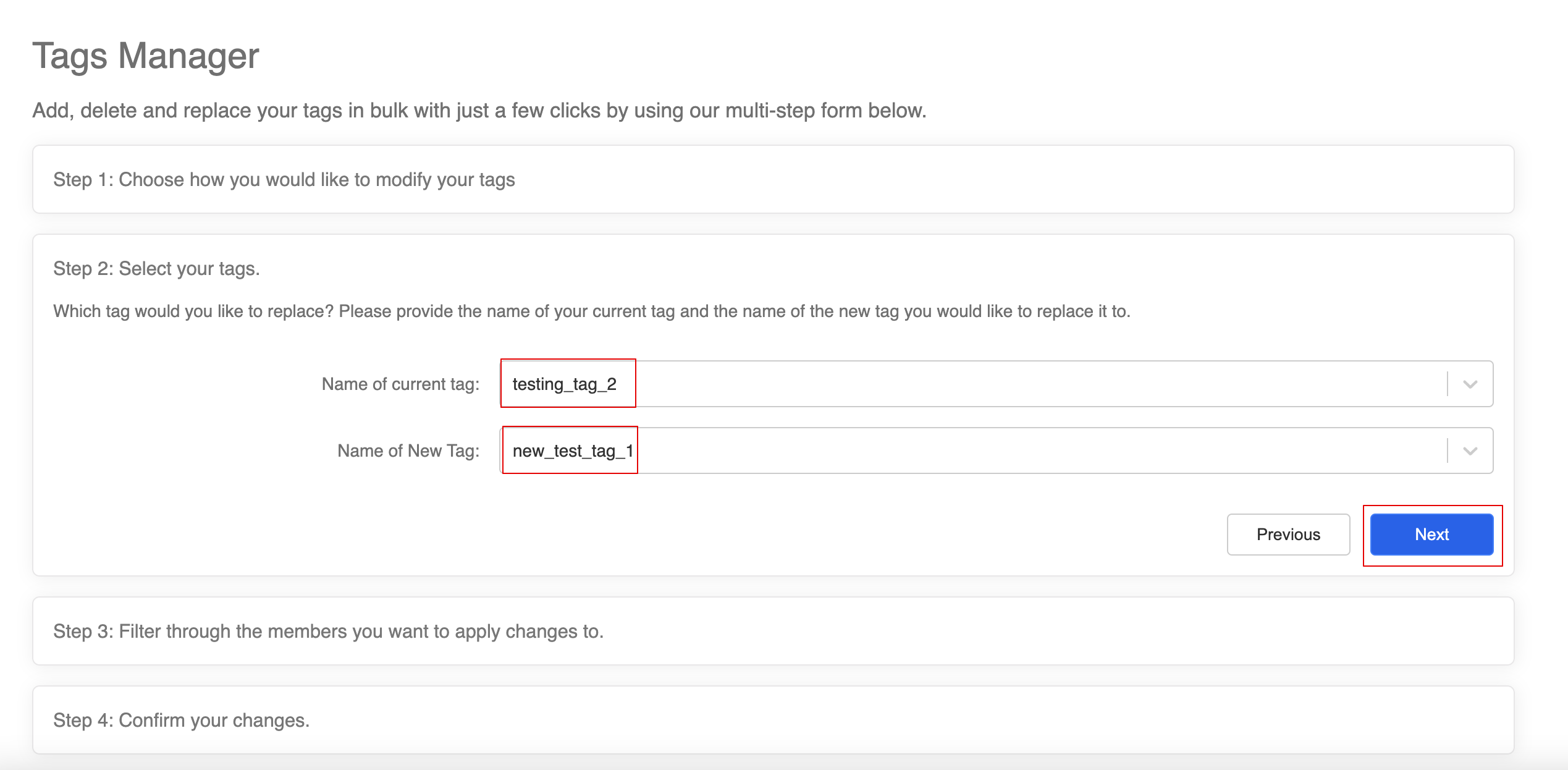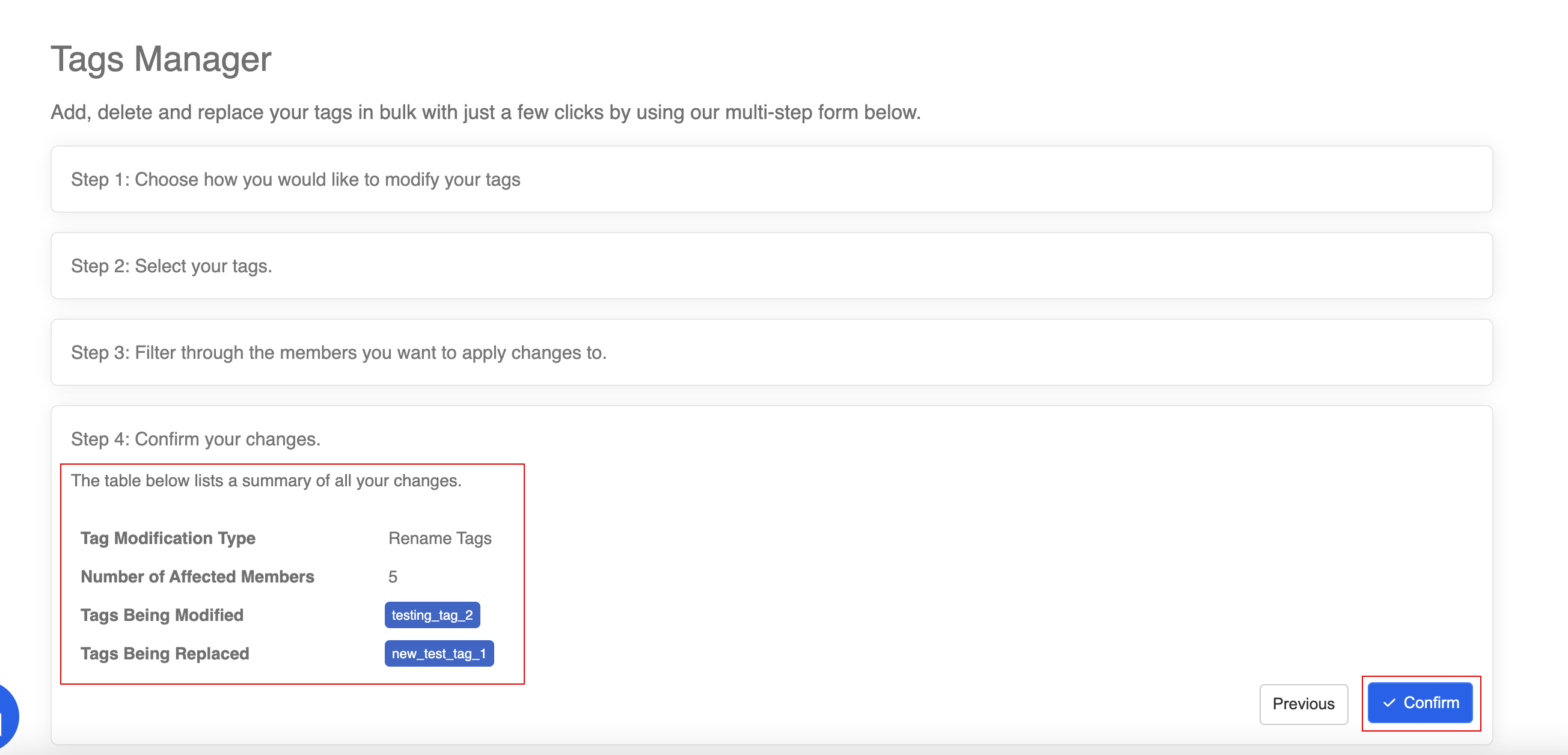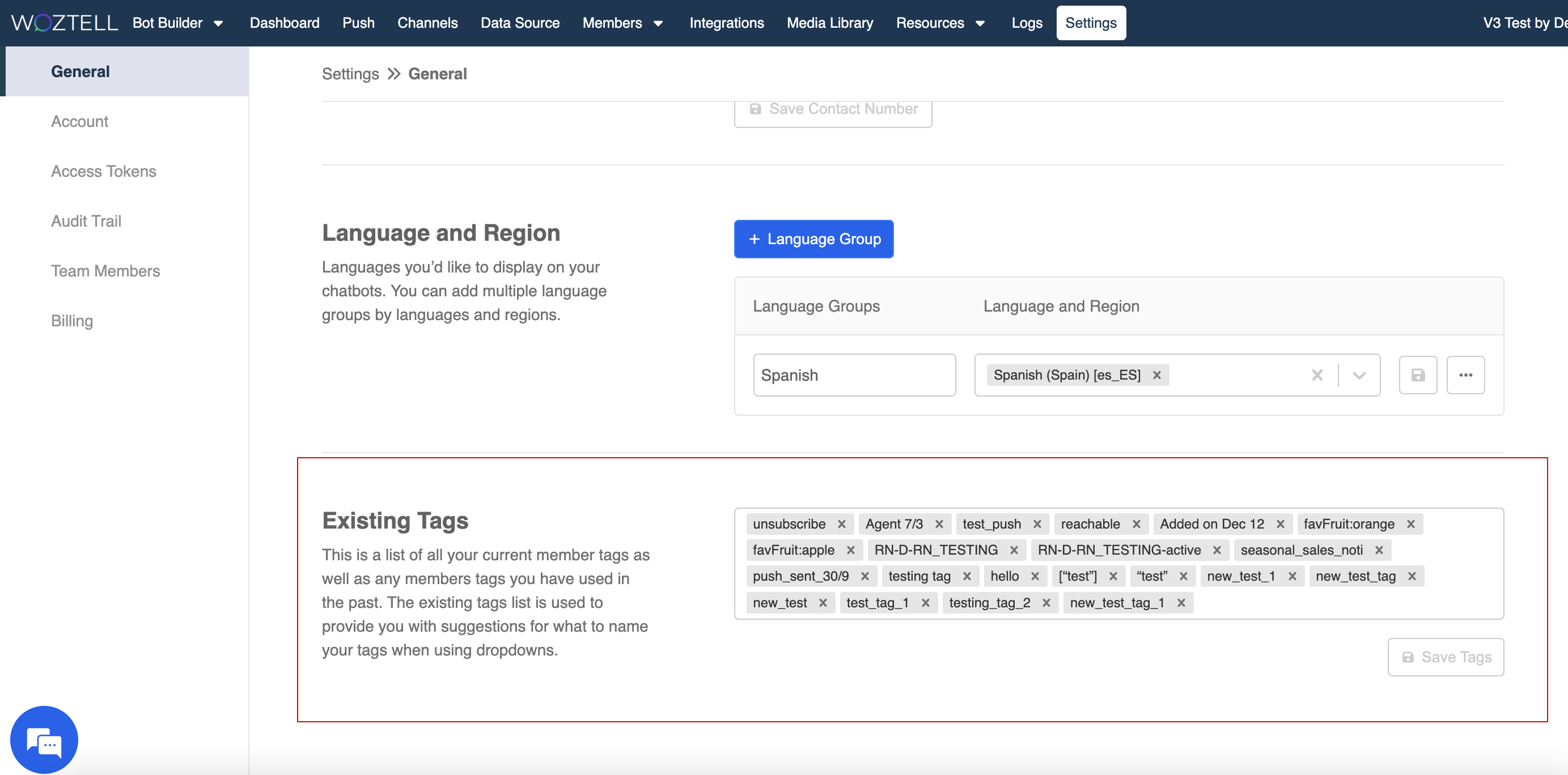Members
Members is the section where you can find the profile of all your subscribers of your chatbots. Anybody who have talked to your chatbot will be displayed here in list view. You can take a look at their tags and detailed conversation history.
Basic Information
You will be able to find the following information within a member: External ID, Name, Tags, Details and Conversation History.
| Property | Description |
|---|---|
| External ID | Applicable to all platforms; a unique string of ID to identify the identity of each member in different platform |
| Name | Only applicable to platforms that provide the name of users |
| Tags | Applicable to all platforms; custom tagging added in Node Inspector ; each tag will be displayed as a blue label |
| Details | Click to view more member details, including "Member Info", "Member Settings" and "Conversation" tabs. |
| Conversation | Click to view all the conversation history of the specific member |
Member Info
The Member Info tab is for displaying the profile information of the member, and allowing you to update the profile if necessary.
Member Settings
The Member Settings tab is for displaying settings specifically related to chatbot, including the following information:
| Property | Description |
|---|---|
| Subscribe/Live Chat | The button will be toggled on automatically once the users subscribe to your chatbot or enter into live chat mode; you may also switch the buttons on/off manually |
| Tags | All member tags belong to this member; you can manually add/delete specific tags created for this channel |
| Locale | Indicate the language setting of this member; you can manually assign another language to the member |
| Chatbot & Node | The position of the user currently is at, and the button can redirect you to the corresponding chatbot or node. |
| Temp Data | For storing useful data of the member which can be extracted by the chatbot, such as the choices made by the users; you can customize it in <Link url="/documentations/node-inspector/actions" text="actions" |
| Meta | Any other customized data to be stored in the member's profile |
Conversation History
The Conversation History tab is for displaying the chat history between you and the member. You can also view it by click "Conversation" directly from the member in the "Members" page.
NOTE
You can also click the top left date picker to filter date/time within a specific range.
If you want to save the conversation as a copy in your local computer, you may click the "Export" button at top right. You will be able to save the conversation history in .CSV.
Create Member
Apart from importing a group of member, you can also create a single member by manually filling in the member information.
- Click "+ Single Member" to create a single member.
- In the "Create Member" modal, first, fill in the mandatory information: Channel and External ID.
- Then, fill in other optional fields. It is always recommended to add the First Name and Last Name as well.
- Some fields such as Emails and Addresses, allow user to save more than one set of the data. For these, user is required to add an customizable alias for each set.
- Click "+ Create Member" to complete the member creation.
- Now, the new member has been created.
Delete Member
WOZTELL also supports deleting member(s) from the member page.
- First, click the checkbox for the member you would like to remove.
- Once a member is selected, a "Delete" icon will appear.
- You can also select all the members. Then, click on the "Delete" icon to proceed.
- Finally, click "Yes, delete it" to confirm the member deletion.
NOTE
- There is no way to revert the deleted member, please be careful with this function.
- If the member has an associated thread in the inbox, it will deleted as well.
- Please be reminded that only Admin and App Owner are allowed to perform this action. Otherwise, you will see the following unauthorized message.
Edit Member
Apart from updating the members by importing, you can also edit the profile of a single member.
- To edit a member profile, select "Details" on a member.
- Under the "Member Info tab, you can see and edit the member profile.
- Click "Save" to confirm the changes.
Export Member List
- You can easily export the list of existing members by clicking the "Export" button on top of the member list.
Notes
- The export will be processed, and a fil will be available for downloading in the "Notifications" section.1.
- The exported file will be in
.csvwith details of the filtered members.
Import Member List
If you already have an existing member list from another source, you can import these members (in .csv format) to WOZTELL. You just need to make sure the following information is correct:
| Label | Description | Required |
|---|---|---|
| externalID | The external ID of the member; It is in a specific format for specific platforms (i.e. Facebook is PSID & WhatsApp is the phone number) | Y |
| tag | The existing tags of the member; It must be text and separated with "," if there are multiple tags | N |
| firstName | The first name of the member | N |
| lastName | The last name of the member | N |
| gender | The gender of the member | N |
| Profile Image URL | URL of the profile image | N |
| locale | The locale of the member | N |
| DOB Year | Year of the date of birth | N |
| DOB Month | Month of the date of birth | N |
| DOB Day | Day of the date of birth | N |
| Phone | Phone number of the member (Not needed for WhatsApp member) | N |
| Email address of the member | N | |
| Address Line 1 | Line 1 of the member's address | N |
| Address Line 2 | Line 2 of the member's address | N |
| Address City | City of the member's address | N |
| Address State | State of the member's address | N |
| Address Country | Country of the member's address | N |
| Address Zip | Zip of the member's address | N |
| Meta | Custom data to be saved to the member's meta | N |
- Click "Import" on top of the member list.
- Choose the corresponding channel to be imported.
- Add the member list in
.csvfile. You can click "Download" to get a copy of a sample member list.
- Once the member list is added, click "Next" to proceed.
- "Your Fields" in the
.csvfile will be listed, and you need to match it with the corresponding "Woztell Fields" by selecting from the picker.
- Only the matched fields will be imported, and it is necessary to have the externalId in order to proceed with the importing.
- For some fields including "Phone", "Email" and "Address", you are required to assign an alias, as our system allows saving more than one set of these information.
- You can also save custom data to the member's meta. You will need to assign the path, for example
meta.crm. Also, you need select one of the supported data type.
| Type | Description | Example |
|---|---|---|
| Text | String | sample_text |
| Number | String; numbers only | 91231 |
| Object | JSON object | {"age":34, "status":"registered", "membership":"VIP"} |
| Array | JSON array | ["item1", "item2", "item3"] |
| Boolean | JSON boolean value | true / false |
- Once you have matched the fields, click "Next" to proceed.
- Apart from importing the member tags, optionally you can also add member tags at this step.
- The member will start being imported soon.
- The progress of the import member can be viewed in the "Notifications sidebar. There will be a report available for downloading if there is any error occurs.
- Now the member has been imported.
Filter Member
On your left, there is a section for your to filter out specific groups of members by Creation Date, Last Active Date, Channel, External ID, Name, Gender, Locale or Tags.
The most common one will be filtering by channels. Just select your filter option and you will see the member details automatically refreshed on your right.
tip
By sharing your member page URL, other users can also view the same page with filters applied (if any).
Custom Filter
Apart from the basic filter, you can also scroll to the bottom and use the custom filter.
By using MongoDB Compass, you can enter your customized criteria, then search and sort any type of object in the member profile. You can also apply the basic filter and the custom filter simultaneously. For example, the custom filter allows you to filter by the information stored in Meta or tempData.
To learn how to apply tempData, you can refer to the advanced standard procedure.
Click here to view all the objects stored under the Member object.
Example 1:
If you have customer satisfaction question, and the score is saved in tempData, you can use filter the members who gave the same score.
Given the score is saved in tempData in this format:
tempData: {
"survey": {
"score": 5
}
}
You can search all the members who gave 5 points:
{"botMeta.tempData.survey.score": {$eq: 5}}
Click here to learn how to how query on embedded documents with MongoDB Compass.
Example 2:
If you want to filter the members who talked to your live chat support, and gave a score of 3 or above, you can also apply two criteria.
Given the information is saved in tempData in this format:
tempData: {
"livechat": true
"survey": {
"score": 4
}
}
You can search for the members who match with both criteria.
{"botMeta.tempData.livechat": true, "botMeta.tempData.survey.score": {$gte: 70}}
Click here to learn the Query and Projection Operators in MongoDB.
Tags Manager
When more and more members accumulate in your app, it will be harder to manage the member tags efficiently. In this case, you can make use of the Tags Manager, which allows you filter out the target group of members, and manage their member tags all at once.
The Tags Manager can be found in the right sidebar inside "Members".
Add new tags
- In the Tags Manager, select "Add new tags" and and click on "Next".
- Select existing tag or simply type to create a new tag. Click "Next" to proceed.
- You can apply any of the filters in order to get the target group of members. Apart from the provided filters, you can also apply custom filter.
- Then, click "Next" to continue.
- Check the summary of the changes, click "Confirm" to start adding the tag(s).
- A message will be displayed in the notification indicating the status of this action.
Delete existing tags
- In the Tags Manager, select "Delete existing tags" and and click on "Next".
- Select the member tags that you would like to delete.
- You can apply any of the filters in order to get the target group of members. Apart from the provided filters, you can also apply custom filter.
- Then, click "Next" to continue.
- Check the summary of the changes, click "Confirm" to start delete the tag(s).
Rename existing tags
- In the Tags Manager, select "Rename existing tags" and and click on "Next".
- Select the existing tag to be renamed, and type to create the new tag.
- You can apply any of the filters in order to get the target group of members. Apart from the provided filters, you can also apply custom filter.
- Then, click "Next" to continue.
- Check the summary of the changes, click "Confirm" to start renaming the tag(s).
Existing Tags List
In the sidebar of the Members page, there is a section called "Existing Tags".
This is a list of member tags that will appear as suggestions when you are adding member tags, allowing you to quickly re-use the existing member tags.
NOTE
Please note that removing tags from this list does not affect the tags applied to any member. It will only remove the tags from the suggestions.


